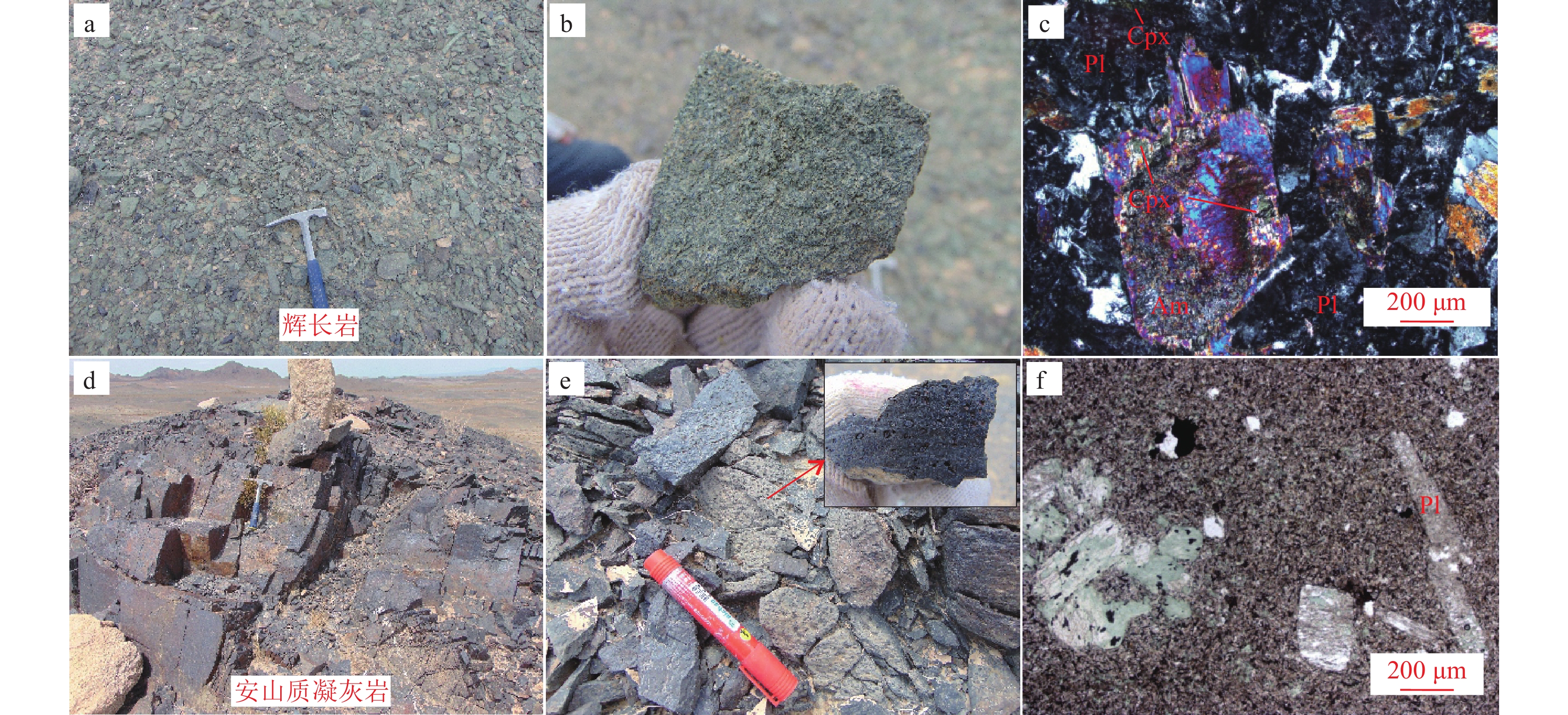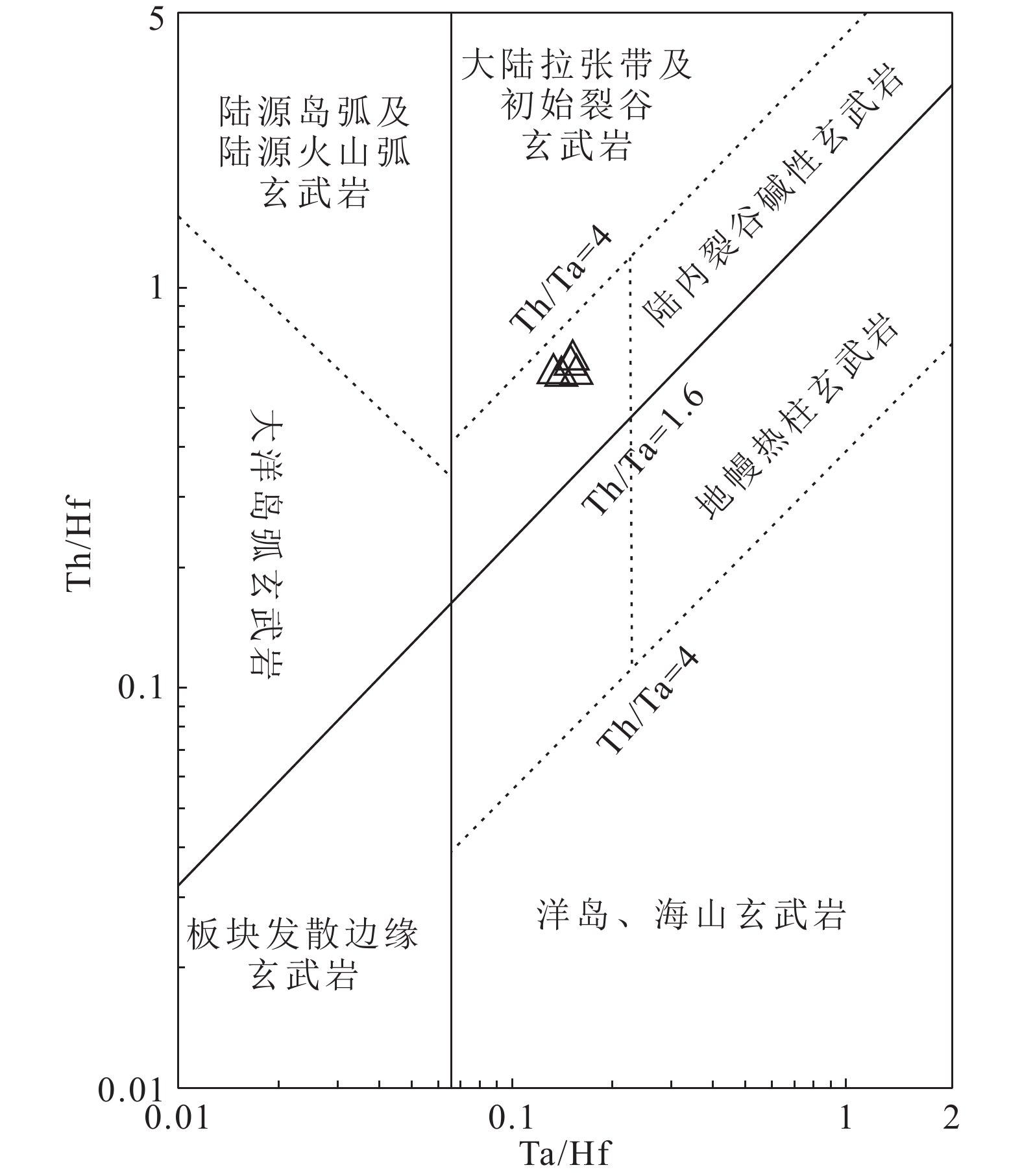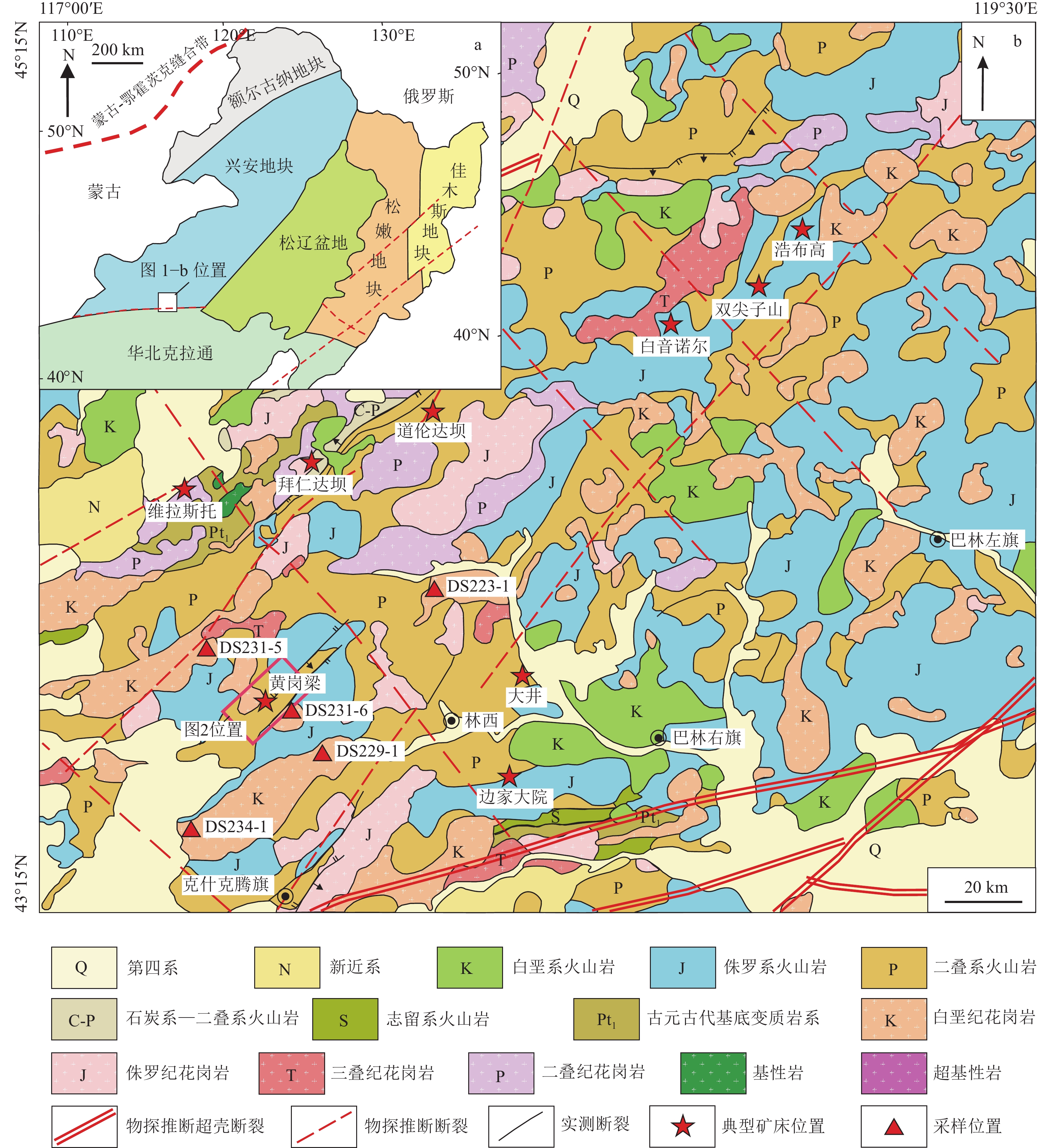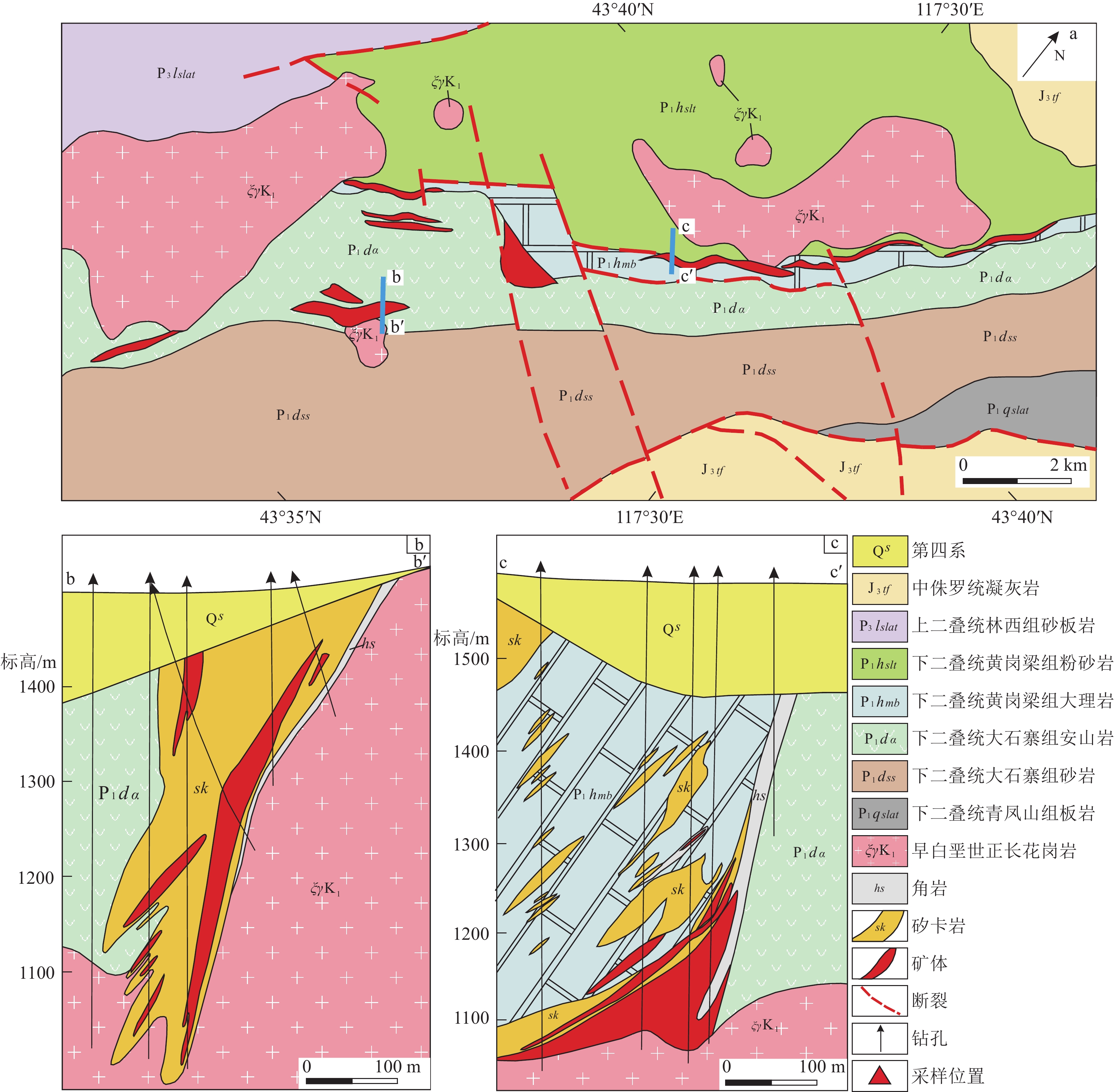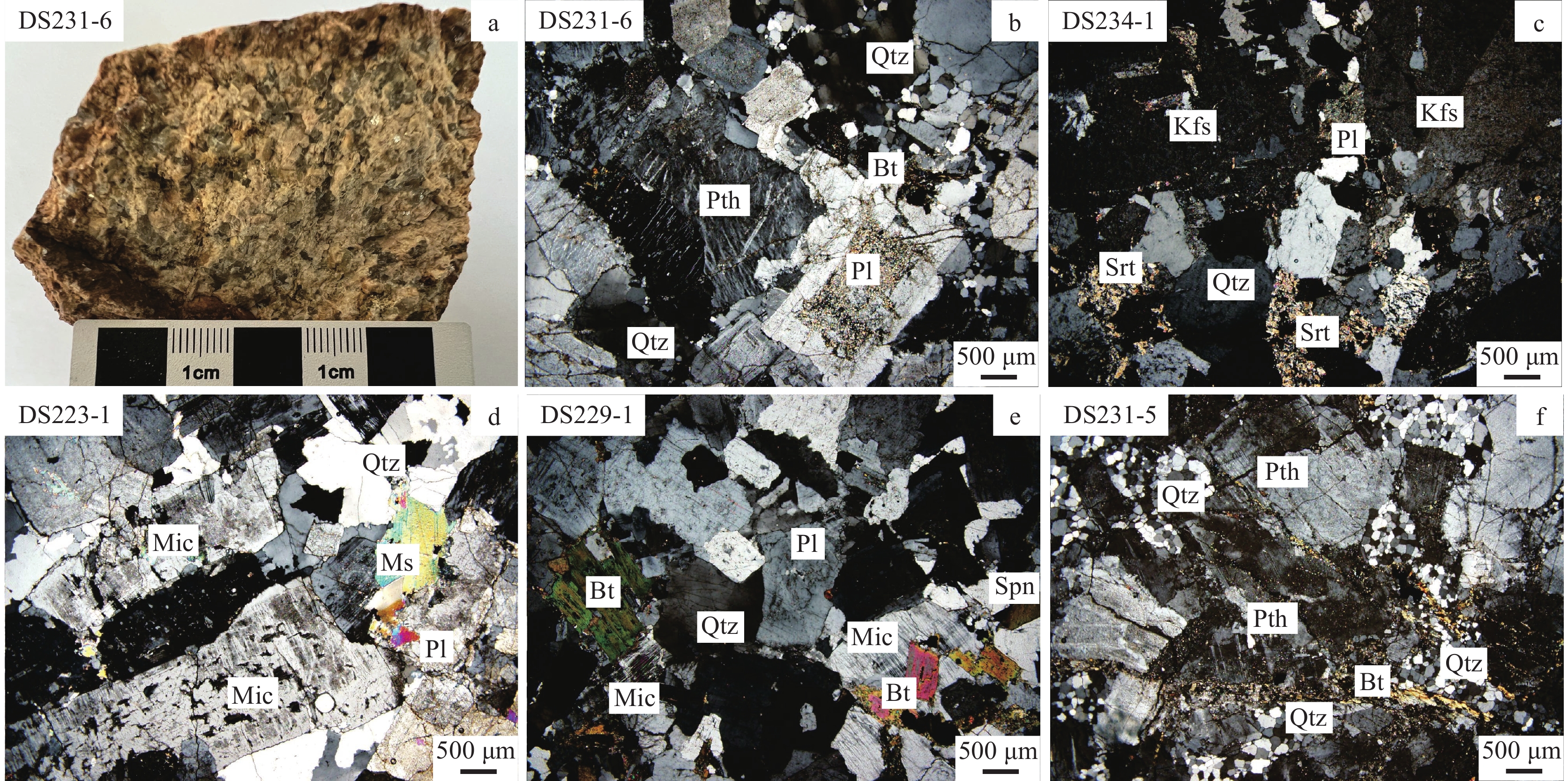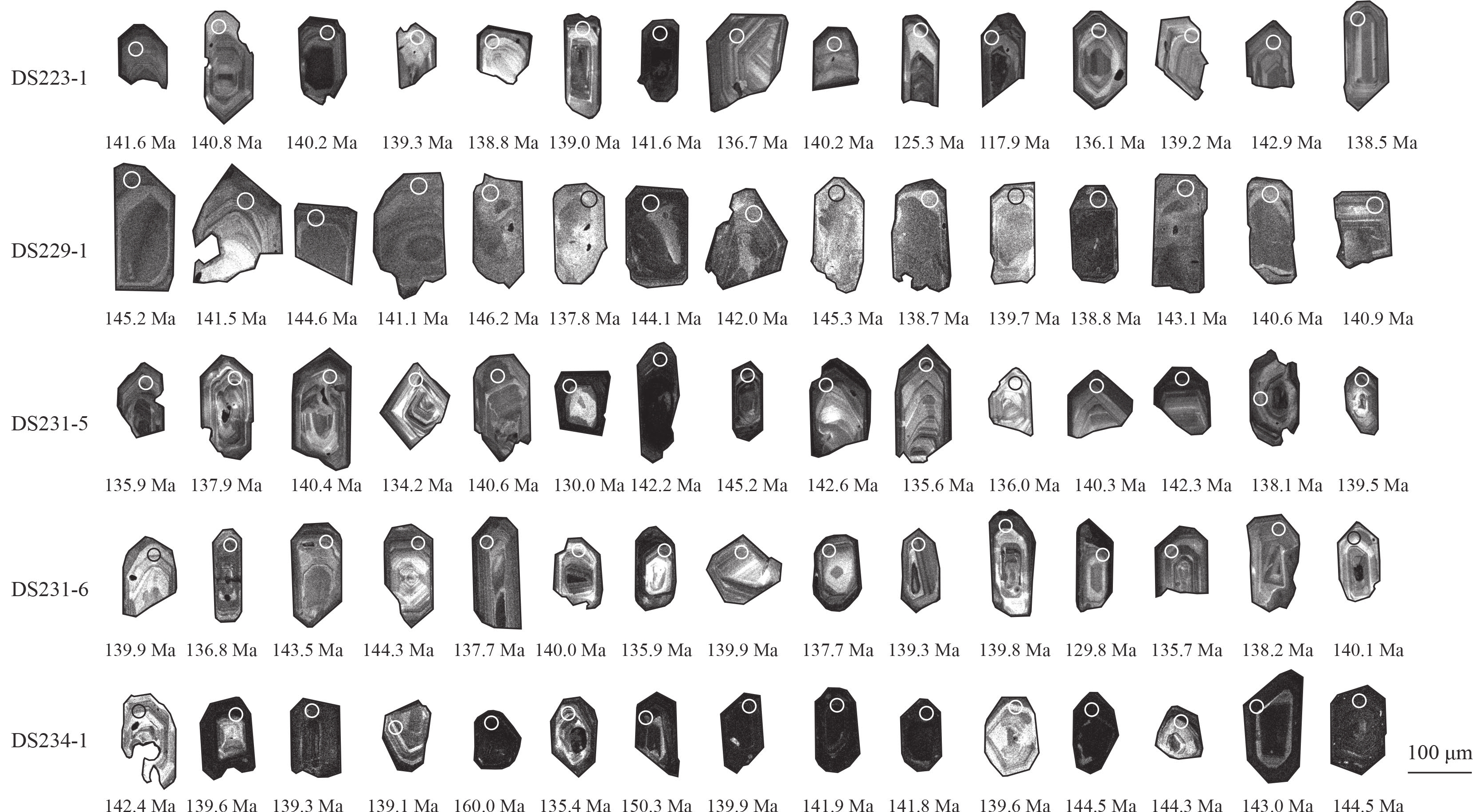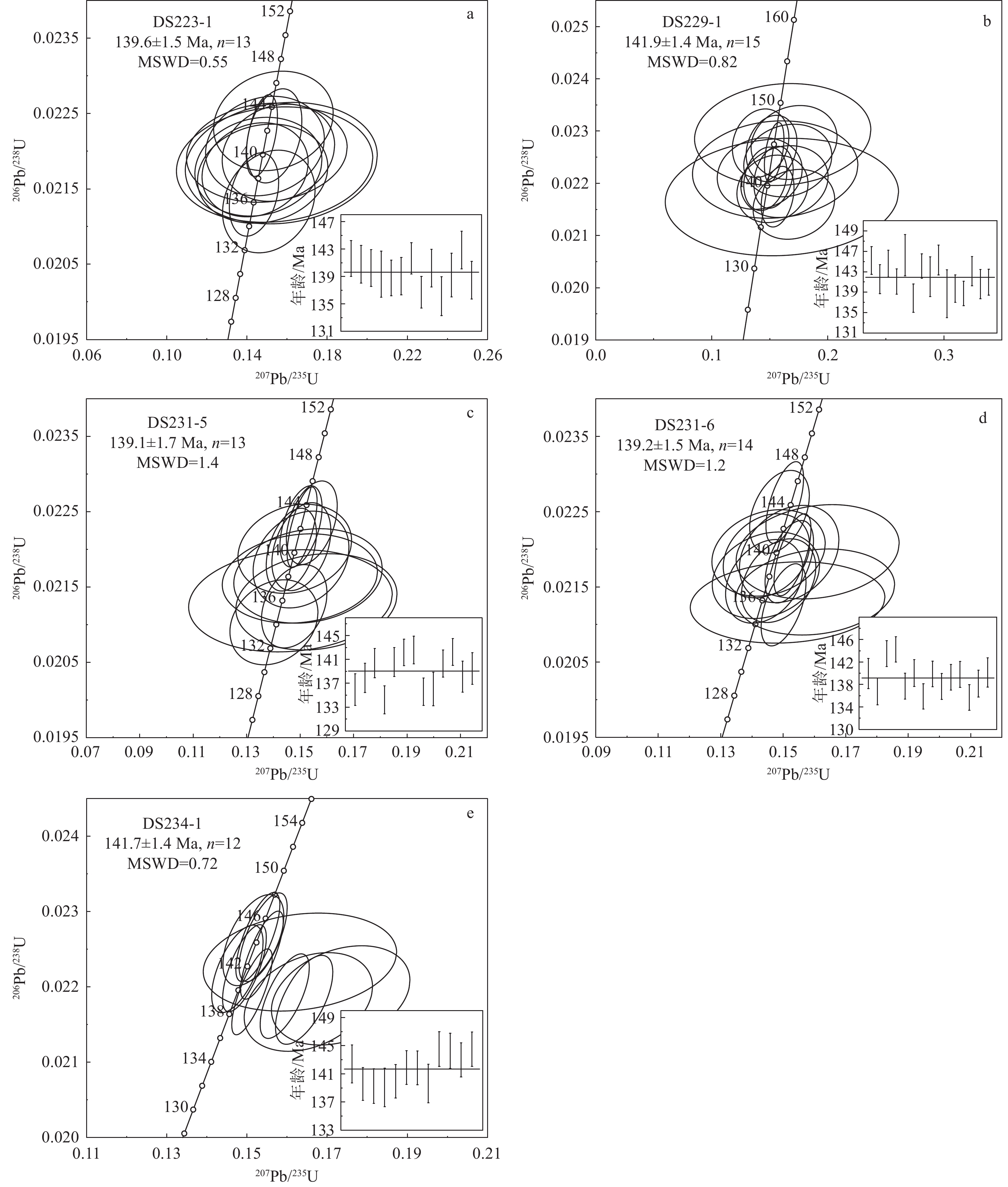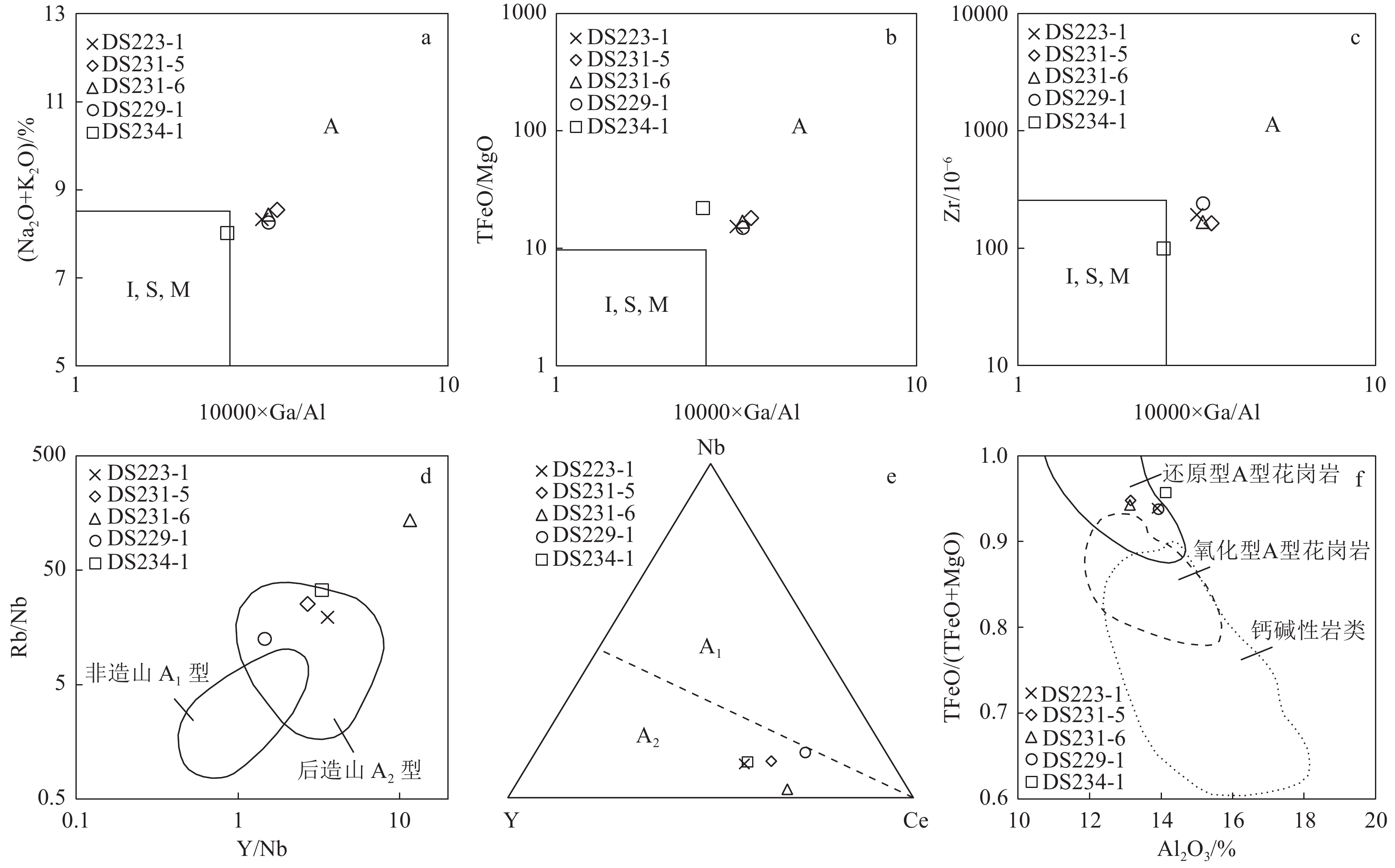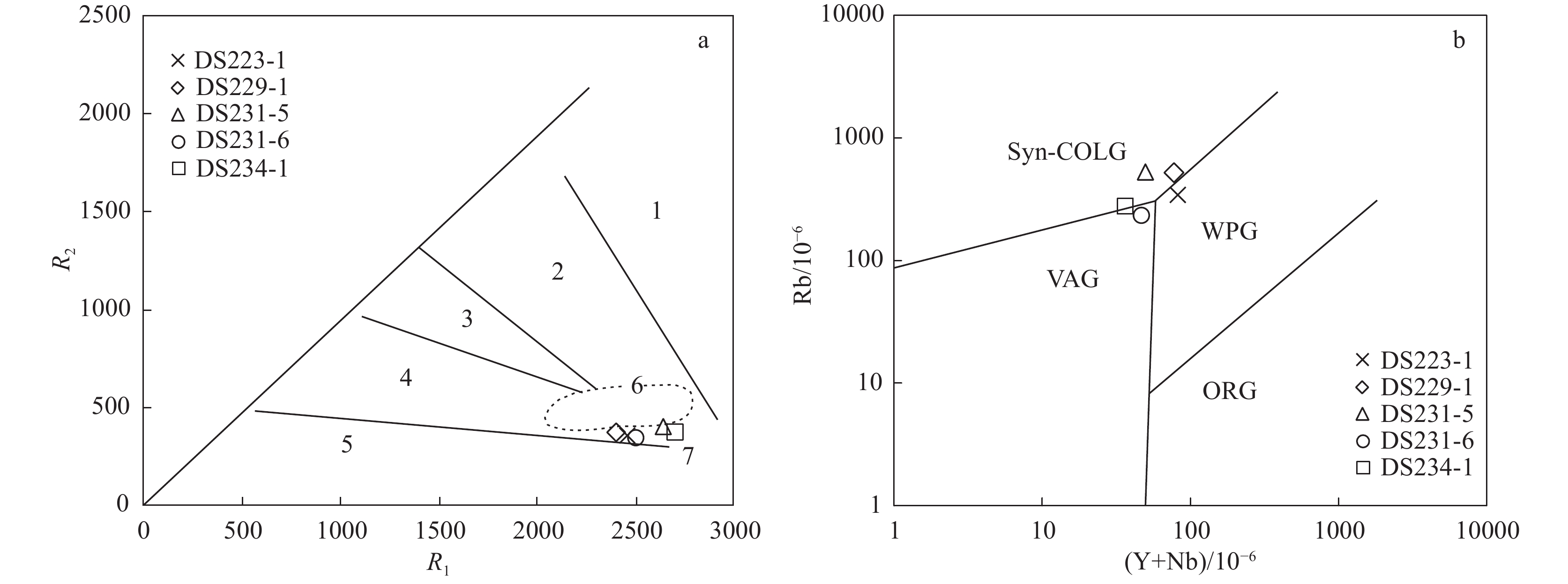Petrogenesis and tectonic implications of the Early Cretaceous syenogranite in Huanggangliang area, southern Great Hinggan Range: Evidence from zircon U−Pb ages, petrogeochemistry and Sr−Nd−Pb isotopes
-
摘要:研究目的
大兴安岭南段黄岗梁锡铁矿区及外围发育大面积花岗岩类,加强其成岩时代、岩石成因类型、成岩成矿物质来源等研究,有利于探究该区成岩与成矿关系和早白垩世碰撞造山机制。
研究方法采集大兴安岭南段黄岗梁锡铁矿区及外围样品,进行岩相学、锆石U−Pb测年、岩石地球化学及Rb−Sr、Sm−Nd、Pb同位素研究。
研究结果获得岩浆结晶年龄为141.9~139.1 Ma,较成矿年龄早约3 Ma,形成于早白垩世。岩石具有高硅、低铝、低镁、富钾少钠特征,为高钾钙碱性A型花岗岩。(87Sr/86Sr)i和143Nd/144Nd值分别介于0.70031~0.70543和0.512572~0.512636之间,εNd(t)值为0.07~ 1.18,Nd同位素模式年龄TDM2为926 ~838 Ma。
结论黄岗梁矽卡岩型锡铁矿床成岩物质于新元古代从亏损地幔分离,在上升侵位过程中受到地壳物质混染。大兴安岭南段地区在早白垩世经历了蒙古–鄂霍次克洋碰撞闭合伸展作用和古太平洋高角度俯冲作用叠加。
Abstract:ObjectiveA large area of granitoids had been developed in the huanggangliang tin-iron mining and its surrounding area in the southern Great Hinggan Range. Thus, the study on its diagenetic age, petrogenetic type and source of diagenetic and ore-forming materials provides important insights to the mechanism of Early Cretaceous collision orogeny in this area and its relationship with mineralization.
MethodsSamples were collected from the Huanggangliang tin−iron mining area and its surrounding areas in the southern Great Hinggan Range for petrography, zircon U−Pb geochronology, rock geochemistry, and Rb−Sr, Sm−Nd, Pb isotope studies.
ResultsThe crystallization ages of these samples range from 141.9 Ma to 139.1 Ma, which was formed during the Early Cretaceous and was about 3 Ma earlier than the mineralization age. The rocks are belong to high potassium calcium alkaline A−type granites with characteristics of high silicon, low aluminum, low magnesium, high potassium and low sodium. The ratios of (87Sr/86Sr)i and 143Nd/144Nd are 0.70031~0.70543 and 0.512572~0.512636, respectively, the value of εNd (t) is 0.07~ 1.18, and the Nd isotope model age TDM2 ranges from 926 Ma to 838 Ma.
ConclusionsThe diagenetic materials of the Huanggangliang skarn tin−iron deposit were separated from the depleted mantle in Neoproterozoic, and experienced crustal contamination during ascending emplacement process. The southern Great Hinggan Range area experienced high−angle subduction of the Paleo−Pacific Ocean plate after post−collisional extension of the Mongol−Okhotsk Ocean closure.
创新点开展大兴安岭南段地区早白垩世典型多金属矿床成岩成矿对比研究和Pb同位素对比研究,提出黄岗梁矽卡岩型锡铁矿床的中酸性侵入岩较成矿年龄早3 Ma左右,代表了与碳酸盐岩的接触交代矿化期。
-
罗迪尼亚(Rodinia)超大陆在新元古代汇聚-裂解,形成古亚洲洋,其演化过程中伴随的岩浆-构造活动及成矿作用是首要解决的科学问题。北山地区位于中亚造山带南缘中段(图1−a),发育大量与罗迪尼亚超大陆汇聚相关的新元古代中期岩浆活动(905~870 Ma)和与大洋俯冲-闭合相关的古生代岩浆活动(姜洪颖等,2013; 叶晓峰等,2013; Liu et al., 2015; 牛文超等,2019; Xiao et al., 2010; Wang et al., 2021;李沅柏等,2021),被视为研究罗迪尼亚超大陆汇聚-裂解和古亚洲洋打开-扩张-俯冲-关闭的重要地区。但由于前寒武纪地层、构造、岩浆岩等遭受后期古生代岩浆-构造热事件强烈的叠加和破坏,北山地区保留的前寒武纪岩石较少(图1−b)。因此,北山地区很少发现与罗迪尼亚超大陆裂解,即古亚洲洋打开相关的岩浆岩证据,致使该区关于古亚洲洋的形成时限及机制研究存在很大的空白。另外,位于北山地区的红山铁矿是与火山活动有关的大型浅海相沉积变质型铁矿(左国朝等,2010),因测年介质的匮乏,其具体形成年代主要依据区域地层对比,缺乏精确的同位素年龄,制约了该矿床的成因研究。针对上述2个问题,本文基于野外调查,对北山地区中部(图1−b)新发现的新元古代中期独红山(红山铁矿区域)辉长岩和位于红山铁矿4矿区的赋矿围岩安山质凝灰岩(图版Ⅰ)开展锆石U−Pb测年和地球化学研究,为研究古亚洲洋的演化时限和完善北山地区前寒武纪构造演化过程提供新的岩石学约束。
![]() 图 1 北山地区大地构造位置图(a)和前寒武纪岩石分布地质简图 (b)(据Xiao et al., 2010修改)① —红石山蛇绿岩带;②—明水-小黄山蛇绿岩带;③—红柳河-牛圈子-洗肠井蛇绿岩带;④—辉铜山-账房山蛇绿岩带Figure 1. Tectonic map (a) and simplified geological map of the distribution of Precambrian rocks (b) in the Beishan area
图 1 北山地区大地构造位置图(a)和前寒武纪岩石分布地质简图 (b)(据Xiao et al., 2010修改)① —红石山蛇绿岩带;②—明水-小黄山蛇绿岩带;③—红柳河-牛圈子-洗肠井蛇绿岩带;④—辉铜山-账房山蛇绿岩带Figure 1. Tectonic map (a) and simplified geological map of the distribution of Precambrian rocks (b) in the Beishan area1. 研究方法
本文在野外调查的基础上,对辉长岩中斜锆石、安山质凝灰岩中锆石使用LA−ICP−MS进行U−Pb同位素分析。斜锆石分析在中国地质调查局西安地质调查中心国土资源岩浆成矿与找矿重点实验室完成,锆石和辉长岩地球化学分析在兰州大学甘肃省西部矿产资源重点实验室完成。斜锆石分析使用斜锆石标样Phalaborwa(PHA)用于外标,计算同位素分馏效应和质量漂移,利用BUSTER软件进行校正计算,未对数据进行普通铅校正。锆石采用91500和NIST610标样分别作为外部标准样和元素含量的外标样,分析结果见表1。
表 1 LA−ICP−MS辉长岩(22NH1)斜锆石和安山质凝灰岩(22NA1)锆石U−Th−Pb分析结果Table 1. LA–ICP–MS baddeleyite and zircon U−Th−Pb dating results of gabbro (22NH1) and andesitic tuff (22NA1)样品点 同位素比值 年龄/Ma Th/U 207Pb/235U 206Pb/238U 207Pb/235U 206Pb/238U 22NH1-1 1.117129 0.067129 0.121764 0.002376 760 33 741 14 22NH1-2 1.264123 0.119984 0.130855 0.006655 827 53 792 38 22NH1-3 1.121016 0.071244 0.118706 0.005253 761 35 723 30 22NH1-4 1.192607 0.104843 0.129957 0.007484 793 47 787 43 22NH1-5 1.159991 0.108900 0.128444 0.005101 776 52 779 29 22NH1-6 1.196924 0.089732 0.126729 0.004735 795 41 769 27 22NH1-7 1.222216 0.085535 0.127834 0.005236 809 38 775 30 22NH1-8 1.183342 0.082417 0.126931 0.006272 791 38 770 36 22NH1-9 1.147928 0.043166 0.123183 0.004378 775 20 749 25 22NH1-10 1.171261 0.053922 0.127390 0.005529 787 26 773 32 22NH1-11 1.218945 0.062680 0.132010 0.004891 807 29 799 28 22NH1-12 1.158849 0.055603 0.129926 0.003349 779 26 787 19 22NH1-13 1.487374 0.108175 0.134216 0.006542 922 44 812 37 22NH1-14 1.079578 0.040262 0.123204 0.003824 743 20 749 22 22NH1-15 1.171701 0.043205 0.124850 0.005035 787 20 758 29 22NH1-16 1.403479 0.168475 0.128608 0.007667 886 69 780 44 22NH1-17 1.206492 0.090860 0.129735 0.006194 801 42 786 35 22NH1-18 1.148425 0.042905 0.124176 0.004229 776 20 755 24 22NH1-19 1.128534 0.073536 0.127147 0.003716 763 36 771 21 22NH1-20 1.188456 0.038565 0.122574 0.005935 795 18 745 34 22NH1-21 1.163731 0.080875 0.123863 0.004524 783 37 753 26 22NH1-22 1.191809 0.065867 0.122917 0.003866 796 31 747 22 22NH1-23 1.219003 0.063952 0.130849 0.004897 808 30 793 28 22NH1-24 1.190767 0.062231 0.130884 0.004749 796 29 793 27 22NH1-25 1.285008 0.098125 0.128891 0.012415 838 45 781 71 22NA1-1 1.10282 0.0302 0.12728 0.00288 772 16 755 15 1.61 22NA1-2 1.09354 0.03944 0.11706 0.00287 714 17 750 19 2.22 22NA1-3 1.16855 0.03693 0.12875 0.00344 781 20 786 17 1.14 22NA1-4 1.10348 0.04122 0.12922 0.00357 783 20 755 20 1.32 22NA1-5 1.12034 0.04114 0.11879 0.00337 724 19 763 20 2.44 22NA1-6 1.08198 0.05187 0.11896 0.00381 725 22 745 25 2.70 22NA1-7 1.14455 0.04978 0.12886 0.00437 781 25 775 24 1.69 22NA1-8 1.74539 0.08037 0.17203 0.00603 1023 33 1025 30 2.00 22NA1-9 1.21976 0.07509 0.13254 0.00563 802 32 810 34 2.44 22NA1-10 1.12936 0.08245 0.12381 0.00552 752 32 767 39 6.25 22NA1-11 1.85548 0.1267 0.16654 0.0077 993 43 1065 45 2.50 22NA1-12 1.16807 0.08771 0.13138 0.00637 796 36 786 41 1.92 22NA1-13 3.05115 0.29745 0.24721 0.01398 1424 72 1421 75 1.35 22NA1-14 4.55978 0.51783 0.31674 0.01904 1774 93 1742 95 1.43 22NA1-15 4.43174 0.54698 0.30534 0.01944 1718 96 1718 102 1.89 22NA1-16 5.58515 0.78992 0.34394 0.02334 1906 112 1914 122 1.61 2. 研究结果
辉长岩体与寒武系双鹰山组和奥陶系罗雅楚山组呈断层接触,岩体主要由辉长岩组成(图版Ⅰ−a)。辉长岩为灰绿色,中细粒辉长结构(图版Ⅰ−b),块状构造,主要由辉石、角闪石和斜长石组成,部分辉石被角闪石和斜长石交代(图版Ⅰ−c)。辉长岩中斜锆石呈短柱状,阴极发光(CL)图像见岩浆振荡环带(图2−a)。25颗斜锆石颗粒(22NH1)的206Pb/238U年龄为812 ± 37~741 ± 14 Ma,其年龄加权平均值为765 ± 10 Ma(MSWD=0.66)(图2−a),代表辉长岩的形成时代为新元古代。辉长岩具低SiO2(47.22%~50.24%)、K2O(0.19%~0.99%)和Na2O(1.43%~2.70%)含量,高CaO(11.57%~12.28%)、MgO(8.06%~8.31%)和TFe2O3(11.50%~11.63%)含量,属于钙碱性拉斑玄武岩系列。岩石亏损Rb、Nb、Ta 和Ti,富集Th和U(图3),Th/Hf值为0.14~0.15,具有大陆板内玄武岩特征,形成于板内(大陆)裂谷构造背景(图4)。
![]() 图 3 辉长岩球粒陨石标准化稀土元素配分图(a)和原始地幔标准化微量元素蛛网图(b)(标准数据据Sun et al., 1989)Figure 3. Chondrite-normalized rare earth element patterns (a) and primitive mantle normalized trace elements diagrams (b) for gabbro
图 3 辉长岩球粒陨石标准化稀土元素配分图(a)和原始地幔标准化微量元素蛛网图(b)(标准数据据Sun et al., 1989)Figure 3. Chondrite-normalized rare earth element patterns (a) and primitive mantle normalized trace elements diagrams (b) for gabbro安山岩质凝灰岩与奥陶系罗雅楚山组呈断层接触。岩石为灰黑色,细粒凝灰结构,块状构造(图版Ⅰ−d),见杏仁状气孔结构(图版Ⅰ−e),主要由火山碎屑(75%)和斜长石(25%)组成凝灰结构(图版Ⅰ−f)。安山质凝灰岩中锆石(22NA1)为短柱状,CL图见岩浆振荡环带(图2−b),Th/U值为1.14 ~ 6.25,属于岩浆锆石。其中6颗206Pb/238U年龄大于1000 Ma,为捕获锆石,其余10颗锆石的206Pb/238U年龄在810 ± 34 ~ 745 ± 25 Ma之间,年龄加权平均值为756 ± 23 Ma(MSWD = 2.2)(图2−b),指示安山质凝灰岩形成于新元古代。
3. 讨 论
北山地区蛇绿岩带的研究表明,古亚洲洋于早寒武世开始发生俯冲消减(Cleven et al., 2015),广泛发育的中酸性、双峰式晚古生代岩浆活动标志着古亚洲洋在晚古生代消亡(Zheng et al., 2020)。说明北山地区在前寒武纪处于拉伸阶段,即大洋在前寒武纪以前已经形成,具体的形成时限仅为最近报道的形成于765 Ma的A1型花岗岩 (卜涛等,2022),并未发现其他的年龄数据。而本文报道的北山地区牛圈子辉长岩和安山质凝灰岩年龄分别为765 Ma和756 Ma。辉长岩地球化学具有拉斑玄武岩特征,形成于板内(大陆)裂谷构造背景(图4),指示可能与罗迪尼亚超大陆的裂解相关,说明北山地区发育一套与古亚洲洋打开相关的新元古代岩浆活动和火山碎屑岩。
研究表明,古亚洲洋的形成是罗迪尼亚超大陆裂解以后的产物。而罗迪尼亚超大陆的汇聚-裂解于1300 ~ 900 Ma在全球范围内开始,中亚地区广泛发育的碱性火山岩、双峰式火山岩等是罗迪尼亚超大陆裂解的直接证据(Wan et al., 2018)。在新元古代中期(约850 Ma)—寒武纪,罗迪尼亚超大陆在中亚地区处于由裂谷扩张为古亚洲洋阶段(Li et al., 2008)。根据已报道的研究,中亚造山带南缘塔里木、柴达木、敦煌-阿拉善地块及华北地块中保存有大量的新元古代岩浆、变质记录,这些事件被认为是这些地块参与到新元古代罗迪尼亚超大陆汇聚-裂解的直接证据(He et al., 2018; Huang et al., 2022; Zheng et al., 2022),如中亚造山带南缘天山发育的900 Ma左右的岩浆事件,华北克拉通835 Ma的板内拉斑辉长岩及苏鲁超高压变质体原岩记录的扬子板块780 Ma的裂解事件(Xu et al., 2005; 许志琴等,2006; 朱强等,2018)。
北山地区位于中亚造山带南缘中段,西接天山造山带,保留了较多的前寒武纪微陆块,特别是新元古代岩浆活动较发育,是研究古亚洲洋打开-扩张的重要区域。北山地区已报道的新元古代岩浆活动有柳园花岗岩(902 Ma)、古堡泉正片麻岩(905~871 Ma)、红石山花岗片麻岩(885 Ma)、花牛山花岗片麻岩(900~890 Ma)、双鹰山花岗片麻岩(895~894 Ma)和黑云母二长花岗岩(892 Ma)及A2型流纹岩(870 Ma),这些新元古代中期岩浆活动均形成于碰撞-后碰撞构造背景(姜洪颖等,2013; 叶晓峰等,2013; Liu et al., 2015; 牛文超等,2019; Wang et al., 2021; 李沅柏等,2021)。说明北山地区在905 ~ 870 Ma处于陆-陆碰撞阶段,而这些岩浆活动可能是罗迪尼亚超大陆在北山地区汇聚-裂解的响应。另外,北山地区明水的784 Ma与陆内裂谷有关的A1型花岗岩,是北山地区发现的最早响应罗迪尼亚超大陆裂解的花岗岩浆记录(卜涛等,2022)。在北山地区红石山埃达克岩中发现的748 Ma岩浆锆石和在中亚造山带南缘塔里木、天山发现的755~740 Ma裂谷型岩浆活动(Su et al., 2011; 杨鑫等,2017),可能与本文报道的辉长岩和安山质凝灰岩指示同一期构造事件,即古亚洲洋的打开。此外,在北山地区中部独红山、洗肠井一带广泛发育一套新元古代中期的火山碎屑沉积建造(余吉远等,2012),指示区域上也处于大陆裂解构造背景。
因此,笔者认为,北山地区在约870 Ma处于罗迪尼亚超大陆的汇聚-裂解转换阶段,765 Ma前古亚洲洋已经打开,发育一系列裂谷型岩浆活动,处于威尔逊旋回的胚胎期。同时,北山红山铁矿赋矿围岩安山质凝灰岩年龄为756 Ma,也说明北山地区红山铁矿形成时代为南华纪(756 Ma),指示成矿构造背景可能与古亚洲洋打开有关。
4. 结 论
(1)北山地区发现的新元古代牛圈子辉长岩和安山质凝灰岩的LA−ICP−MS斜锆石和锆石年龄分别为765 Ma和756 Ma。
(2)辉长岩地球化学特征具有板内裂谷背景下的拉斑玄武质岩浆性质。结合区域构造演化,古亚洲洋南段在北山地区打开时限不早于765 Ma。
(3)北山红山铁矿形成于南华纪。
致谢:对中国地质调查局西安地质调查中心汪双双高级工程师在斜锆石LA−ICP−MS测试,以及审稿专家对文章提出的宝贵修改意见表示诚挚的感谢。
-
图 2 黄岗梁锡铁矿区地质图(a)及深部剖面图(b, c)(据Mei et al.,2015修改)
Figure 2. Geological map (a) and cross sections (b, c) of the Huanggangliang Fe-Sn deposit
图 6 黄岗梁地区正长花岗岩Q−A−P图解(a, 底图据Streckeisen et al., 1979)和SiO2−K2O图解(b, 底图据Peccerillo et al., 1976)
1—富石英花岗岩; 2—碱性长石花岗岩; 3a—正长花岗岩; 3b—二长花岗岩;4—花岗闪长岩; 5—云英闪长岩; 6*—石英碱性长石正长岩; 7*—石英正长岩; 8*—石英二长岩; 9*—石英二长闪长岩/石英二长辉长岩; 10*—石英闪长岩/石英辉长岩; 6—碱性长石正长岩; 7—正长岩; 8—二长岩; 9—二长闪长岩/二长辉长岩; 10—闪长岩/辉长岩/斜长岩
Figure 6. Q−A−P diagram(a) and SiO2−K2O diagram(b) of the syenogranites in Huanggangliang area
图 7 黄岗梁地区正长花岗岩微量元素原始地幔标准化图解(a)和稀土元素球粒陨石标准化图解(b)(标准值据Sun et al., 1989; 天山-兴安平均值据史长义等, 2007)
Figure 7. Primitive mantle-normalized trace elements patterns (a) and chondrite-normalized REE patterns (b) of the syenogranites in Huanggangliang area
图 9 黄岗梁地区正长花岗岩成因类型判别图(a, b, c图底图据Whalen et al., 1987; d, e图底图据Eby, 1992; f图底图据Dall’ Agnol et al., 2007)
Figure 9. A-type granite of discrimination diagrams of the syenogranites in Huanggangliang area
图 10 Pb同位素构造模式图(a, 底图据Zartman et al., 1981)和(87Sr/86Sr)i-(143Nd/144Nd)i图解(b, 底图据Zindler et al., 1986)(a图黄岗梁花岗岩5件样品据蔡剑辉等, 2004; Zhou et al., 2012; 黄岗梁矿石14件样品据要梅娟等, 2012; 刘智等, 2013; 白音诺尔11件样品据Jiang et al., 2017; Zhao et al., 2020;浩布高5件样品据 Wang et al., 2018; 道伦达坝14件样品据周振华等, 2014; 维拉斯托8件样品据刘瑞麟等, 2018. b. 黄岗梁花岗岩6件样品据Zhou et al., 2012; 苏荣昆等, 2022; 白音诺尔24件样品据Jiang et al., 2017; Zhao et al., 2020; 浩布高5件样品据Wang et al., 2018; 双尖子山12件样品据Dai et al., 2022)
Figure 10. Pb isotopic compositions diagram(a) and (87Sr/86Sr)i-(143Nd/144Nd)i diagram(b)
图 11 黄岗梁地区正长花岗岩R1−R2图解 (a, 底图据Batchelor et al., 1985)和(Y+Nb)−Rb图解(b, 底图据Pearce et al., 1984)(R1=[4Si-11(Na + K)-2(Fe + Ti)]; R2=(Al + 2Mg + 6Ca))
1—地幔分异(斜长花岗岩); 2—破坏性活动板块边缘(板块碰撞前)花岗岩; 3—板块碰撞后隆起期花岗岩; 4—晚造山期花岗岩; 5—非造山期A型花岗岩; 6—同碰撞S型花岗岩; 7—造山期后A型花岗岩;ORG—洋中脊花岗岩; Syn-COLG—同碰撞花岗岩; VAG—火山弧花岗岩; WPG—板内花岗岩
Figure 11. R1−R2 diagram (a) and (Y+Nb)−Rb diagram (b) of the syenogranites in Huanggangliang area
表 1 黄岗梁地区正长花岗岩锆石U−Th−Pb同位素数据
Table 1 U−Th−Pb data of zircons obtained from the syenogranites in Huanggangliang area
测点 普通Pb/% U/10−6 Th/10−6 232Th/
238U放射性Pb/
10−6206Pb*/
238U1σ/% 207Pb*/
235U1σ/% 207Pb*/
206Pb*1σ/% 误差相
关系数206Pb/238U
年龄/Ma207Pb/206Pb
年龄/Ma不谐和度/% DS223-1 1.1 0.61 223 90 0.42 4.29 0.02221 1.9 0.1538 6.0 0.0502 5.7 0.312 141.6±2.6 205±130 31 2.1 1.45 268 98 0.38 5.16 0.02208 2.0 0.149 13 0.0490 13 0.150 140.8±2.7 147±300 5 3.1 1.12 286 131 0.47 5.46 0.02199 1.9 0.156 12 0.0514 12 0.162 140.2±2.7 259±270 46 4.1 2.28 130 55 0.44 2.49 0.02185 2.4 0.157 20 0.052 20 0.121 139.3±3.4 295±450 53 5.1 1.70 306 121 0.41 5.81 0.02176 1.9 0.144 12 0.0481 12 0.156 138.8±2.6 103±280 −34 6.1 2.65 213 83 0.40 4.09 0.02180 2.0 0.146 14 0.0485 14 0.138 139.0±2.7 125±330 −11 7.1 0.42 1206 401 0.34 23.1 0.02222 1.6 0.1476 3.5 0.0482 3.1 0.463 141.6±2.3 108±73 −31 8.1 0.61 667 192 0.30 12.4 0.02143 1.7 0.1436 5.7 0.0486 5.4 0.299 136.7±2.3 128±130 −6 9.1 1.91 258 112 0.45 4.97 0.02199 2.0 0.150 18 0.0495 18 0.111 140.2±2.7 171±410 18 10.1 5.40 79 27 0.35 1.40 0.01964 3.4 0.146 36 0.054 36 0.095 125.3±4.2 366±810 66 11.1 2.85 180 69 0.40 2.94 0.0185 5.5 0.126 21 0.049 21 0.256 117.9±6.4 169±480 30 12.1 0.77 243 138 0.59 4.50 0.02134 2.1 0.151 10 0.0513 9.9 0.209 136.1±2.8 256±230 47 13.1 3.36 158 75 0.49 3.07 0.02183 2.3 0.154 21 0.051 21 0.110 139.2±3.2 247±480 44 14.1 1.47 256 123 0.49 5.00 0.02241 1.9 0.153 13 0.0496 13 0.151 142.9±2.7 179±300 20 15.1 1.76 237 95 0.41 4.49 0.02171 2.0 0.148 14 0.0495 14 0.138 138.5±2.7 171±340 19 DS229-1 1.1 1.09 463 161 0.36 9.17 0.02278 1.9 0.142 11 0.0451 11 0.167 145.2±2.7 −52±270 381 2.1 1.59 447 172 0.40 8.66 0.02220 2.0 0.141 17 0.0461 17 0.118 141.5±2.8 1±410 −26820 3.1 0.86 569 192 0.35 11.2 0.02268 1.8 0.151 9.6 0.0484 9.4 0.193 144.6±2.6 117±220 −24 4.1 1.40 424 130 0.32 8.17 0.02213 1.8 0.153 7.3 0.0501 7.1 0.243 141.1±2.5 198±160 29 5.1 4.74 115 16 0.14 2.38 0.02295 2.8 0.161 31 0.051 31 0.090 146.2±4.1 231±720 37 6.1 2.12 245 88 0.37 4.65 0.02161 2.0 0.170 14 0.0571 13 0.149 137.8±2.8 496±300 72 7.1 0.54 1633 397 0.25 31.9 0.02261 1.7 0.1534 3.6 0.0492 3.2 0.463 144.1±2.4 157±75 8 8.1 4.81 131 50 0.39 2.64 0.02228 2.8 0.154 31 0.050 30 0.091 142.0±3.9 203±710 30 9.1 1.26 262 106 0.42 5.20 0.02279 2.0 0.171 14 0.0543 14 0.143 145.3±2.9 383±320 62 10.1 7.20 67 24 0.38 1.35 0.02175 3.4 0.160 41 0.053 41 0.082 138.7±4.7 344±930 60 11.1 2.02 286 100 0.36 5.50 0.02191 1.9 0.152 13 0.0503 13 0.146 139.7±2.7 207±310 32 12.1 0.88 576 174 0.31 10.9 0.02176 1.8 0.1565 6.0 0.0522 5.7 0.293 138.8±2.4 292±130 52 13.1 2.63 245 96 0.41 4.85 0.02245 2.0 0.165 15 0.0533 15 0.135 143.1±2.9 342±340 58 14.1 1.59 192 74 0.40 3.70 0.02205 2.1 0.162 15 0.0534 15 0.135 140.6±2.9 346±340 59 15.1 1.07 370 103 0.29 7.11 0.02210 1.8 0.146 8.4 0.0478 8.2 0.216 140.9±2.5 90±190 −56 DS231-5 1.1 1.27 206 97 0.49 3.82 0.02131 2.0 0.156 13 0.0532 13 0.155 135.9±2.7 336±280 60 2.1 2.41 437 193 0.46 8.33 0.02162 1.8 0.150 13 0.0503 13 0.142 137.9±2.5 210±290 34 3.1 1.37 431 148 0.36 8.27 0.02202 1.8 0.148 9.5 0.0488 9.3 0.187 140.4±2.5 139±220 −1 4.1 1.21 360 165 0.47 6.58 0.02104 1.8 0.140 7.8 0.0484 7.6 0.228 134.2±2.4 118±180 −14 5.1 0.60 350 172 0.51 6.66 0.02205 1.7 0.1506 4.8 0.0495 4.5 0.360 140.6±2.4 174±110 19 6.1 0.57 495 156 0.33 8.71 0.02036 1.7 0.1453 4.7 0.0518 4.4 0.362 130.0±2.2 275±100 53 7.1 0.21 1890 632 0.35 36.3 0.02230 1.6 0.1509 2.4 0.0491 1.9 0.647 142.2±2.2 151±44 6 8.1 0.38 1541 722 0.48 30.3 0.02278 1.6 0.1581 2.6 0.0503 2.1 0.605 145.2±2.3 210± 49 31 9.1 0.40 854 281 0.34 16.5 0.02236 1.6 0.1545 4.1 0.0501 3.7 0.403 142.6±2.3 199±87 28 10.1 0.40 513 205 0.41 9.41 0.02126 1.7 0.1479 5.5 0.0505 5.2 0.314 135.6±2.3 217±120 38 11.1 1.46 227 82 0.37 4.23 0.02133 2.1 0.147 17 0.0498 17 0.122 136.0±2.8 187±400 27 12.1 0.47 1107 354 0.33 21.0 0.02201 1.6 0.1469 4.2 0.0484 3.9 0.390 140.3±2.3 120±91 −17 13.1 0.31 1642 486 0.31 31.6 0.02231 1.6 0.1505 3.5 0.0489 3.1 0.465 142.3±2.3 143±72 1 14.1 1.18 256 82 0.33 4.82 0.02166 1.9 0.153 12 0.0513 12 0.159 138.1±2.6 254±270 46 15.1 1.03 516 211 0.42 9.80 0.02187 1.9 0.151 7.9 0.0499 7.7 0.244 139.5±2.7 190±180 27 DS231−6 1.1 0.92 354 116 0.34 6.73 0.02195 1.9 0.152 6.9 0.0503 6.7 0.279 139.9±2.7 207±150 32 2.1 5.92 778 361 0.48 15.2 0.02144 1.8 0.160 10 0.0543 10 0.168 136.8±2.4 382±230 64 3.1 0.41 937 337 0.37 18.2 0.02251 1.6 0.1489 4.2 0.0480 3.9 0.384 143.5±2.3 99± 92 −45 4.1 0.17 1795 648 0.37 35.0 0.02263 1.6 0.1506 2.7 0.0483 2.1 0.596 144.3±2.3 113± 50 −28 5.1 0.35 524 202 0.40 9.75 0.02159 1.7 0.1486 5.3 0.0499 5.0 0.321 137.7±2.3 192±120 28 6.1 0.84 381 171 0.46 7.24 0.02196 1.7 0.145 8.2 0.0480 8.1 0.210 140.0±2.4 101±190 −39 7.1 2.31 1693 908 0.55 31.7 0.02130 1.7 0.152 14 0.0516 13 0.123 135.9±2.2 268±310 49 8.1 − 837 251 0.31 15.8 0.02194 1.6 0.1531 2.6 0.0506 2.0 0.637 139.9±2.3 224± 46 37 9.1 0.36 573 186 0.34 10.7 0.02158 1.7 0.1441 5.6 0.0484 5.4 0.302 137.7±2.3 119±130 −15 10.1 0.19 811 438 0.56 15.2 0.02184 1.7 0.1521 3.3 0.0505 2.9 0.496 139.3±2.3 218± 67 36 11.1 1.54 740 274 0.38 14.2 0.02192 1.7 0.1447 6.3 0.0479 6.1 0.267 139.8±2.3 93±140 −50 12.1 1.25 621 137 0.23 11.0 0.02035 1.7 0.1417 5.9 0.0505 5.6 0.291 129.8±2.2 219±130 41 13.1 0.00 617 291 0.49 11.3 0.02127 1.7 0.1502 3.1 0.0512 2.7 0.538 135.7±2.3 251±61 46 14.1 0.67 574 218 0.39 10.8 0.02166 1.8 0.145 7.8 0.0484 7.6 0.224 138.2±2.4 119±180 −16 15.1 1.52 317 178 0.58 6.08 0.02198 1.9 0.161 11 0.0532 11 0.176 140.1±2.6 337±240 58 DS234-1 1.1 0.82 272 125 0.47 5.26 0.02234 1.9 0.163 9.8 0.0530 9.6 0.197 142.4±2.7 328±220 57 2.1 0.13 1129 309 0.28 21.3 0.02189 1.7 0.1594 2.5 0.0528 1.9 0.672 139.6±2.3 321± 42 57 3.1 − 656 442 0.70 12.3 0.02184 1.8 0.1643 2.9 0.0545 2.3 0.621 139.3±2.5 394± 50 65 4.1 0.17 346 118 0.35 6.50 0.02181 2.0 0.165 6.4 0.0550 6.1 0.310 139.1±2.7 411±140 66 5.1 0.24 8903 12035 1.40 193 0.02514 1.8 0.1688 2.1 0.0487 1.1 0.858 160.0±2.8 134± 25 −19 6.1 0.02 726 359 0.51 13.3 0.02123 1.9 0.1603 4.0 0.0547 3.5 0.481 135.4±2.6 402±78 66 7.1 0.15 3585 2252 0.65 72.8 0.02359 1.7 0.1651 2.2 0.0508 1.4 0.777 150.3±2.5 230±31 35 8.1 0.01 2278 562 0.25 43.0 0.02194 1.7 0.1512 2.2 0.05 1.4 0.776 139.9±2.4 194±32 28 9.1 0.19 2625 715 0.28 50.3 0.02226 1.7 0.1494 2.4 0.0487 1.7 0.706 141.9±2.4 133±40 −7 10.1 0.32 2294 578 0.26 44.0 0.02225 1.7 0.1475 2.8 0.0481 2.3 0.606 141.8±2.4 104±53 −36 11.1 0.49 266 140 0.54 5.03 0.02190 2.0 0.173 6.6 0.0574 6.3 0.302 139.6±2.7 508±140 73 12.1 0.23 2546 646 0.26 49.7 0.02267 1.7 0.1527 2.4 0.0488 1.6 0.724 144.5±2.5 140±38 −3 13.1 0.23 1527 640 0.43 29.8 0.02263 1.8 0.1516 3.3 0.0486 2.8 0.530 144.3±2.5 128±66 −13 14.1 0.18 2249 487 0.22 43.4 0.02243 1.7 0.1537 2.2 0.0497 1.4 0.765 143.0±2.4 181± 34 21 15.1 0.18 2865 708 0.26 55.9 0.02267 1.7 0.1540 2.6 0.0493 1.9 0.671 144.5±2.4 160±44 10 表 2 黄岗梁地区正长花岗岩主量、微量和稀土元素含量
Table 2 Major, trace elements and rare earth elements compositions of the syenogranites in Huanggangliang area
元素 DS223-1 DS231-5 DS231-6 DS229-1 DS234-1 天山-兴安 SiO2 73.41 74.34 75.11 73.35 75.16 72.73 TiO2 0.20 0.17 0.08 0.22 0.09 0.26 Al2O3 13.89 13.15 13.13 13.93 14.14 14.04 Fe2O3 2.17 1.88 0.93 2.38 1.22 0.90 FeO 1.03 1.53 0.72 0.65 0.76 0.89 MnO 0.05 0.04 0.04 0.05 0.04 0.04 MgO 0.19 0.18 0.09 0.19 0.08 0.46 CaO 0.70 1.11 1.56 0.61 0.88 1.32 Na2O 3.25 3.73 2.82 3.04 3.08 3.86 K2O 5.08 4.82 5.62 5.22 4.93 4.09 P2O5 0.05 0.04 0.02 0.05 0.03 0.07 烧失量 0.90 0.45 0.52 0.89 0.25 - 总量 100.9 101.4 100.6 100.5 100.67 - TFeO 2.98 3.22 1.56 2.79 1.86 1.70 Na2O+K2O 8.33 8.55 8.44 8.26 8.01 7.95 K2O/Na2O 1.56 1.29 1.99 1.72 1.60 1.06 A/CNK 1.14 0.98 0.97 1.18 1.18 - A/NK 1.28 1.16 1.22 1.31 1.36 - DI 90.1 90.1 90.5 90.5 90.72 - σ43 2.28 2.34 2.22 2.24 2.00 - AR 2.61 3.19 2.25 2.44 2.39 - M 1.55 1.79 1.89 1.50 1.49 - t 792 760 756 815 741 - Hf 10.30 7.04 7.28 7.16 3.92 4.70 Ta 2.25 3.72 2.23 2.20 1.50 0.92 Th 15.90 45.11 49.93 13.82 17.32 12.80 U 2.51 19.73 16.54 3.52 7.11 2.13 Ba 343.44 151.91 108.45 386.59 260.82 461 Cr 2.91 6.47 5.35 5.60 2.07 4 Ga 23.23 24.17 22.84 24.25 19.11 18 Pb 90.48 14.34 8.36 30.23 18.79 19 Nb 17.93 20.85 3.94 18.91 8.44 11 Rb 347.92 527.66 537.74 237.14 282.65 125 Sr 59.49 54.09 53.72 78.71 117.81 179 Zr 193.83 163.62 168.21 241.19 99.75 141 Y 64.37 56.28 45.79 27.70 27.90 19 10000*Ga/Al 3.16 3.47 3.29 3.29 2.55 2.42 Nb/Ta 7.97 5.61 1.77 8.59 5.64 11.95 Zr/Hf 18.83 23.24 23.11 33.69 25.44 30.0 La 45.66 56.64 49.87 19.91 21.31 26 Ce 93.67 113.10 103.80 92.61 42.23 52 Pr 11.78 12.38 11.97 5.35 5.10 5.76 Nd 43.22 42.31 41.44 20.34 18.31 21.2 Sm 8.64 8.62 8.78 5.38 4.25 3.9 Eu 0.83 0.90 0.82 0.99 0.74 0.72 Gd 7.41 7.68 7.66 4.85 3.60 4.50 Tb 1.24 1.30 1.29 0.86 0.62 0.55 Dy 6.89 7.37 6.92 4.87 3.32 3.70 Ho 1.12 1.24 1.16 0.85 0.57 0.74 Er 3.00 3.61 3.12 2.36 1.65 2.18 Tm 0.32 0.44 0.37 0.30 0.22 0.38 Yb 2.25 3.16 2.42 2.05 1.53 2.20 Lu 0.24 0.36 0.28 0.25 0.18 0.33 ΣREE 226.27 259.10 239.91 160.97 103.61 124.16 LREE/HREE 9.07 9.30 9.33 8.82 7.87 7.52 Eu /Eu* 0.32 0.34 0.31 0.59 0.58 0.17 注:A/CNK=(Al2O3)/[(CaO)+(Na2O)+(K2O)],DI(标准矿物组分:石英+正长石+钠长石+霞石+白榴石+六方钾霞石)。M=(Na+K+2Ca)/(Al×Si)(阳离子比率);t(°C)=12900/{ln[ 496000 /ω(Zr)]+0.85M+2.95}−273.5,据Watson et al.(1983)。主量元素含量单位为%,微量和稀土元素含量单位为10−6表 3 黄岗梁地区正长花岗岩Rb−Sr、Sm−Nd、Pb同位素数据
Table 3 Rb−Sr, Sm−Nd and Pb isotopic compositions of the syenogranites in Huanggangliang area
样号 DS223-1 DS229-1 DS231-5 DS231-6 DS234-1 Rb/10−6 382 232 593 561 286 Sr/10−6 56.4 89.5 51.8 47.1 102 87Rb/86Sr 19.6 7.4917 33.0899 34.4911 8.0822 87Sr/86Sr 0.742105 0.719977 0.765734 0.773669 0.719964 误差 0.000014 0.000013 0.000013 0.000014 0.000014 (87Sr/86Sr)i 0.70321 0.70487 0.70031 0.70543 0.70369 εSr(t) −16 7.6 −57.2 15.5 −9.1 Sm/10−6 10.3 4.54 8.57 9.35 4.52 Nd/10−6 51.8 20.6 46.3 46 21.2 147Sm/144Nd 0.1202 0.1331 0.112 0.1228 0.129 143Nd/144Nd 0.512572 0.51261 0.512591 0.512629 0.512636 误差 0.000007 0.000008 0.000008 0.000007 0.000007 (143Nd/144Nd)i 0.512462 0.512486 0.512489 0.512517 0.512516 εNd(0) −1.29 −0.55 −0.92 −0.18 −0.04 εNd(t) 0.07 0.6 0.59 1.13 1.18 fSm/Nd −0.39 −0.32 −0.43 −0.38 −0.34 TDM/Ma 945 1024 841 877 928 TDM2/Ma 926 885 885 840 838 208Pb/204Pb 38.426 38.381 38.984 39.942 38.905 误差 0.003 0.005 0.005 0.005 0.009 207Pb/204Pb 15.543 15.541 15.608 15.609 15.609 误差 0.001 0.002 0.002 0.002 0.003 206Pb/204Pb 18.683 18.565 19.91 19.979 19.789 误差 0.002 0.002 0.002 0.003 0.003 表 4 大兴安岭南段典型矿床年龄及与成矿有关岩体年龄
Table 4 Age data of typical ore deposits and the granitic intrusions associated with the mineralization of southern Great Hinggan Range
矿床名称 矿床类型 测试对象 样号 测试方法 年龄 资料来源 黄岗梁
锡−铁−锌矿床矽卡岩型 矿石 HG-4-1;HG-2-28 ~ HG-2-31 辉钼矿Re−Os 135.3 ± 0.85 Ma 周振华等,2010a 矿石 07HGL-04 辉钼矿Re−Os 141.2 ± 4.3 Ma 要梅娟等,2016 矿石 07HGL-05 辉钼矿Re−Os 134.9 ± 5.2 Ma 翟德高等,2012 锡矿脉 —— 钾长石K−Ar 137 ± 3 Ma Ishiyama et al., 2001 钻孔1337.5 m矽卡岩 HGL-93 石榴石U−Pb LA−ICP−MS 136.03 ± 1.22 Ma Li et al., 2022 钻孔1250 m锡矿石 HGL-220 锡石U−Pb 137.10 ± 3.65 Ma Li et al., 2022 钻孔1200 m花岗岩 HGL-243 锆石U−Pb LA−ICP−MS 138.45 ± 0.45 Ma Li et al., 2022 矿区细粒花岗岩 —— 白云母K−Ar 142 ± 3 Ma Ishiyama et al., 2001 矿区花岗岩 WL1 锆石U−Pb LA−ICP−MS 139.96 ± 0.87 Ma 翟德高等,2012 矿区钾长花岗岩 HG-1-7 锆石U−Pb LA−ICP−MS 136.7 ± 1.1 Ma 周振华等,2010b 矿区花岗斑岩 HG-3-5 锆石U−Pb LA−ICP−MS 136.8 ± 0.57 Ma 周振华等,2010b 当中营子钾长花岗岩 14RS-7 锆石U−Pb LA−ICP−MS 137.7 ± 1.2 Ma 赵辉等,2015 浩布高
铅−锌−铜−锡
矿床矽卡岩型 矿石 HL13 辉钼矿Re−Os 142 ± 1 Ma Liu et al.,2017 矿石 HBG01 ~ HBG05 辉钼矿Re−Os 138 ± 3 Ma Wang et al.,2018 矿石 17HBG-1 辉钼矿Re−Os 138.27 ± 0.81 Ma Hong et al.,2021 矿石 17HBG-2 辉钼矿Re−Os 138.82 ± 0.80 Ma Hong et al.,2021 矿石 Grt A 石榴石U−Pb LA−ICP−MS 139.10 ± 5.40 Ma Hong et al.,2021 矿石 Grt B 石榴石U−Pb LA−ICP−MS 140.70 ± 1.89 Ma Hong et al.,2021 矿区花岗岩 HBG-9 锆石U−Pb LA−ICP−MS 143.49 ± 0.76 Ma Hong et al.,2021 矿区黑云母花岗岩 HBG-10 锆石U−Pb LA−ICP−MS 141.10 ± 1.40 Ma Hong et al.,2021 矿区蚀变花岗斑岩 HBG-1 锆石U−Pb LA−ICP−MS 140.97 ± 0.73 Ma Hong et al.,2021 矿区花岗斑岩 HBG-13 锆石U−Pb LA−ICP−MS 140.85 ± 0.75 Ma Hong et al.,2021 矿区黑云母花岗岩 ZK2507-17-2 锆石U−Pb LA−ICP−MS 140.9 ± 0.8 Ma Niu et al.,2022 钻孔920 m花岗岩 ZK0605 锆石U−Pb LA−ICP−MS 139 ± 2 Ma Wang et al.,2018 小罕山二长花岗岩 XHS-02 锆石U−Pb LA−ICP−MS 143.9 ± 1.1 Ma 周桐等,2022 小罕山石英二长斑岩 XHS 锆石U−Pb LA−ICP−MS 140 ± 2 Ma Liu et al.,2021 乌兰坝黑云母花岗岩 WLB 锆石U−Pb LA−ICP−MS 142 ± 2 Ma Liu et al.,2021 乌兰楚鲁特花岗岩 WLCLT 锆石U−Pb LA−ICP−MS 139 ± 2 Ma Liu et al.,2021 双尖子山
铅−锌−银矿床岩浆热液型 矿石 17SJ-34; 17SJ-35;
17SJ-41辉钼矿Re−Os 134.9 ± 3.4 Ma Zhai et al.,2020 矿石 15SJ-10; 15SJ-16;
17SJ-26; 15SJ-114黄铁矿Re−Os 135.0 ± 0.6 Ma Zhai et al.,2020 矿石 SJ-30-1 ~ 4; SJ-55-
1 ~ 3; SJ-68-1 ~ 3闪锌矿Rb−Sr 132.7 ± 3.9 Ma 吴冠斌等,2014 石英正长斑岩 NS-17 锆石U−Pb LA−ICP−MS 131.4 ± 0.5 Ma 赵家齐等,2022 矿区正长花岗岩 SJ-52 锆石U−Pb LA−ICP−MS 133.71 ± 0.64 Ma 吴冠斌等,2014 钻孔1021 m花岗斑岩 DS233-8 锆石U−Pb SHRIMP 133.4 ± 1.2 Ma 顾玉超等,2017a 斑状花岗闪长岩 14SJ55 锆石U−Pb LA−ICP−MS 130 ± 6 Ma Liu et al.,2016 矿区花岗岩 17SJ-87 锆石U−Pb LA−ICP−MS 135.2 ± 1.4 Ma Zhai et al.,2020 矿区粗粒花岗岩 17SJ-53 锆石U−Pb LA−ICP−MS 134.4 ± 1.0 Ma Zhai et al.,2020 矿区细粒花岗岩 17SJ-59 锆石U−Pb LA−ICP−MS 134.4 ± 1.0 Ma Zhai et al.,2020 钻孔细粒正长花岗岩 ZK1237-4 锆石U−Pb LA−ICP−MS 140.72 ± 0.44 Ma Dai et al.,2022 钻孔二长花岗岩 ZK101-1 锆石U−Pb LA−ICP−MS 142.7 ± 0.82 Ma Dai et al.,2022 道伦达坝
锡−铜−钨矿床岩浆热液型 矿石 DL 石英包裹体Ar−Ar 140.6 ± 2.2 Ma 张雪冰等,2021 矿石 DX3 锡石U−Pb 136.8 ± 7.4 Ma 陈公正等,2018 矿石 DX1 锡石U−Pb 134.7 ± 6.6 Ma 陈公正等,2018 矿石 DL2 独居石U−Pb LA−ICP−MS 136 ± 2.3 Ma 陈公正等,2021 矿石 D8-2 独居石U−Pb LA−ICP−MS 135.1 ± 2.2 Ma 陈公正等,2021 矿石 DX8 独居石U−Pb LA−ICP−MS 134.7 ± 2.8 Ma 陈公正等,2021 矿石 D13 绢云母Ar−Ar 140.0 ± 1.1 Ma 陈公正等,2021 张家营子似斑状花岗岩 DW1-2 锆石U−Pb LA−ICP−MS 135 ± 1 Ma 陈公正等,2018 张家营子细粒花岗岩 DW3-9 锆石U−Pb LA−ICP−MS 136 ± 1 Ma Chen et al.,2021b 张家营子细粒花岗岩 DW3-3 锆石U−Pb LA−ICP−MS 134 ± 1 Ma Chen et al.,2021b 张家营子细粒花岗岩 ZYZ 全岩Rb−Sr 139.3 ± 2.9 Ma 毛骞等,2001 维拉斯托−拜仁达坝
锡−铜−钨−铅−锌−银
矿床岩浆热液型 矿石 WLST09-7 辉钼矿Re−Os 135 ± 11 Ma Liu et al.,2016 矿化石英斑岩 AY1 锡石U−Pb 138 ± 6 Ma Wang et al.,2017 矿化云英岩 AY2 锡石U−Pb 135 ± 6 Ma Wang et al.,2017 石英脉矿石 W22 锡石U−Pb 136.0 ± 6.1 Ma 刘瑞麟等,2018 北大山花岗岩 BD1-1 锆石U−Pb LA−ICP−MS 140 ± 2 Ma 刘瑞麟等,2018 北大山二长花岗岩 WH-01 锆石U−Pb LA−ICP−MS 140 ± 3 Ma Liu et al.,2016 北大山岩体外围花岗岩 BR2011-10 锆石U−Pb LA−ICP−MS 139 ± 2 Ma Liu et al.,2016 钻孔1550 m石英斑岩 ZK809-1 锆石U−Pb LA−ICP−MS 138 ± 2 Ma Liu et al.,2016 钻孔500 m石英斑岩 WL1 锆石U−Pb LA−ICP−MS 135.7 ± 0.9 Ma 翟德高等,2016 矿区碱长花岗岩 WLST01 锆石U−Pb LA−ICP−MS 139.5 ± 1.2 Ma 祝新友等,2016 边家大院
铅−锌−银矿床岩浆热液型 矿石 BJ-07 ~ BJ-11 辉钼矿Re−Os 140.7 ± 1.7 Ma Zhai et al.,2017 矿石 —— 绢云母Ar−Ar 137.9 ± 4.1 Ma Zhai et al.,2017 矿区黑云母二长花岗岩 BJN2 锆石U−Pb LA−ICP−MS 143.2 ± 1.2 Ma Wang et al.,2016 矿区正长花岗岩 DS211-1 锆石U−Pb LA−ICP−MS 140.31 ± 0.34 Ma 顾玉超等,2017b 钻孔884 m石英斑岩 BJ-58 锆石U−Pb LA−ICP−MS 140.2 ± 1.2 Ma 王喜龙等,2014b 矿区花岗闪长岩 BJY-YT 锆石U−Pb LA−ICP−MS 143.2 ± 1.5 Ma 阮班晓等,2013 花岗斑岩 BJP1-C22 锆石U−Pb LA−ICP−MS 138.2 ± 0.8 Ma 蒋昊原等,2020 辉石闪长岩 BJP1-C31 锆石U−Pb LA−ICP−MS 137.4 ± 0.7 Ma 蒋昊原等,2020 乌兰坝粗粒花岗岩 HL02 锆石U−Pb LA−ICP−MS 138.0 ± 1.4 Ma Xu et al.,2022 乌兰坝粗粒花岗岩 HL04 锆石U−Pb LA−ICP−MS 137.1 ± 0.6 Ma Xu et al.,2022 -
Batchelor R A, Bowden P. 1985. Petrogenetic interpretation of granitoid rock series using multication parameters[J]. Chemical Geology, 48(1): 43−55.
Black L P, Kamo S L, Allen C M, et al. 2003. TEMORA 1: A new zircon standard for Phanerozoic U−Pb geochronology[J]. Chemical Geology, 200(1/2): 155−170. doi: 10.1016/S0009-2541(03)00165-7
Cai J H, Yan G H, Xiao C D, et al. 2004. Nd, Sr, Pb isotopic characteristics of the Mesozoic intrusive rocks in Taihang−Da Hinggan Mountains tectonomagmatic belt and their source region[J]. Acta Petrologica Sinica, 20(5): 1225−1242 (in Chinese with English abstract).
Cao H H, Xu W L, Pei F P, et al. 2013. Zircon U−Pb geochronology and petrogenesis of the Late Paleozoic−Early Mesozoic intrusive rocks in the eastern segment of the northern margin of the North China Block[J]. Lithos, 170/171: 191–207.
Chappell B W, White A J R. 1974. Two contrasting granite types[J]. Pacific Geology, 8: 173−174.
Chappell B W, White A J R. 1992. I− and S−type granites in the Lachlan Fold Belt[J]. Transactions of the Royal Society of Edinburgh: Earth Sciences, 83(1/2): 1−26.
Che Y W, Liu J F, Zhao S, et al. 2021. Early Early−Cretaceous post−collisional tectonic setting of the southern segment of the Great Xing’an Range: Evidence from the Lanjiayingzi gabbro−diorite in Linxi area[J]. Geological Bulletin of China, 40(1): 152–163 (in Chinese with English abstract).
Chen G Z, Wu G, Li T G, et al. 2018. LA−ICP−MS zircon and cassiterite U−Pb ages of Daolundaba copper−tungstentin deposit in Inner Mongolia and their geological significance[J]. Mineral Deposits, 37(2): 225−245 (in Chinese with English abstract).
Chen G Z, Wu G, Li T G, et al. 2021a. Mineralization of the Daolundaba Cu−W−Sn deposit in the southern Great Xing’an Range: Constraints from zircon and monazite U−Pb and sericite 40Ar−39Ar ages[J]. Acta Petrologica Sinica, 37(3): 865−885 (in Chinese with English abstract). doi: 10.18654/1000-0569/2021.03.14
Chen G Z, Wu G, Li T G, et al. 2021b. Mineralization of the Daolundaba Cu−Sn−W−Ag deposit in the southern Great Xing’an Range, China: Constraints from geochronology, geochemistry, and Hf isotope[J]. Ore Geology Reviews, 133: 104117.
Clemens J D, Holloway J R, White A J R. 1986. Origin of an A−type granite: Experimental constraints[J]. American Mineralogist, 71(3/4): 317−324.
Collins W J, Beams S D, White A J R, et al. 1982. Nature and origin of A−type granites with particular reference to Southeastern Australia[J]. Contributions to Mineralogy and Petrology, 80(2): 189−200. doi: 10.1007/BF00374895
Dai M, Yan G S, Li Y S, et al. 2022. The origin of microgranular enclaves in the Early Cretaceous Shuangjianzishan granites in southern Great Hinggan Range, NE China[J]. Geological Journal, 57(7): 2631–2655.
Dall’Agnol R, Carvalho de Oliveira D. 2007. Oxidized, magnetite−series, rapakivi−type granites of Carajas, Brazil: Implications for classification and petrogenesis of A−type granites[J]. Lithos, 93: 215−233. doi: 10.1016/j.lithos.2006.03.065
Deng J F, Zhao G C, Su S G, et al. 2005. Structure overlap and tectonic setting of Yanshan orogenic belt in Yanshan Era[J]. Geotectonica et Metallogenia 29(2): 157–165 (in Chinese with English abstract).
Dickin A P. 1994. Nd isotope chemistry of Tertiary igneous rocks from Arran, Scotland: Implications for magma evolution and crustal structure[J]. Geological Magazine, 131(3): 329−333. doi: 10.1017/S0016756800011092
Duan X X, Zeng Q D, Yang Y H, et al. 2015. Triassic magmatism and Mo mineralization in northeast China: geochronological and isotopic constraints from the Laojiagou porphyry Mo deposit[J]. International Geology Review, 57(1): 55−75. doi: 10.1080/00206814.2014.989546
Eby G N. 1992. Chemical subdivision of the A−type granitoids: Petrogenetic and tectonic implications[J]. Geology, 20(7): 641−644. doi: 10.1130/0091-7613(1992)020<0641:CSOTAT>2.3.CO;2
Engebretson D C, Cox A, Gordon R G. 1985. Relative motions between oceanic and continental plates in the Pacific basin[J]. Special Paper of the Geological Society of America, 206(9): 1−60.
Fan W M, Guo F, Wang Y J, et al. 2003. Late Mesozoic calc−alkaline volcanism of post−orogenic extension in the northern Da Hinggan Mountains, northeastern China[J]. Journal of Volcanology and Geothermal Research, 121: 115−135. doi: 10.1016/S0377-0273(02)00415-8
Feng Y Z, Yang J H, Sun J F, et al. 2020. Material records for Mesozoic destruction of the North China Craton by subduction of the Paleo−Pacific slab[J]. Science China Earth Sciences, 63: 690−700 (in Chinese with English abstract). doi: 10.1007/s11430-019-9564-4
Frost C D, Frost B R. 1997. Reduced rapakivi−type granites: the tholeiite connection[J]. Geology, 25(7): 647−650. doi: 10.1130/0091-7613(1997)025<0647:RRTGTT>2.3.CO;2
Gu Y C, Chen R Y, Jia B, et al. 2017a. Zircon U−Pb dating and geochemistry of the granite porphyry from the Shuangjianzishan silver polymetallic deposit in Inner Mongolia and tectonic implications[J]. Geology and Exploration, 53(3): 495−507 (in Chinese with English abstract).
Gu Y C, Chen R Y, Jia B, et al. 2017b. Zircon U−Pb dating and geochemistry of the syenogranite from the Bianjiadayuan Pb−Zn−Ag deposit of Inner Mongolia and its tectonic implications[J]. Geology in China, 44(1): 101−117 (in Chinese with English abstract).
Guo Z J, Zhou Z H, Li G T, et al. 2012. SHRIMP U−Pb zircon dating and petrogeochemistral characteristics of the intermediate−acid intrusive rocks in the Aoergai copper deposit of Inner Mongolia[J]. Geology in China, 39(6): 1487−1500 (in Chinese with English abstract).
Han B F, Wang S G, Jahn B, et al. 1997. Depleted−mantle source for the Ulungur River A−type granites from North Xinjiang, China: Geochemistry and Nd−Sr isotopic evidence, and implications for Phanerozoic crustal growth[J]. Chemical Geology, 138(3/4): 135−159. doi: 10.1016/S0009-2541(97)00003-X
Harris C, Marsh J S, Milner S C. 1999. Petrology of the alkaline core of the Messum igneous complex, Nambibia: Evidence for the progressively decreasing effect of crustal contamination[J]. Journal of Petrology, 40(9): 1377−1397. doi: 10.1093/petroj/40.9.1377
Hong J X, Zhang H Y, Zhai D G, et al. 2021. The geochronology of the Haobugao skarn Zn−Pb deposit (NE China) using garnet LA−ICP−MS U−Pb dating[J]. Ore Geology Reviews, 139: 1−23.
Hou Z Q. 2010. Metallogensis of continental collision[J]. Acta Geologica Sinica, 84(1): 30−58 (in Chinese with English abstract).
Ishiyama D, Mizuta T, Ishikawa Y, et al. 2001. Geochemical characteristics of igneous rocks and tin−copper mineralization[R]. Project Final Report of Chinese Research Center for Mineral Resources Exploration, 4: 115–138.
Jiang H Y, Zhao Z D, Zhu X Y, et al. 2020. Characteristics and metallogenic significance of granite porphyry and pyroxene diorite in the Bianjiadayuan Pb−Zn−Ag polymetallic deposit, Inner Mongolia[J]. Geology in China, 47(2): 450−471 (in Chinese with English abstract).
Jiang S H, Chen C L, Bagas L, et al. 2017. Two mineralization events in the Baiyinnuoer Zn−Pb deposit in Inner Mongolia, China: Evidence from field observations, S−Pb isotopic compositions and U−Pb zircon ages[J]. Journal of Asian Earth Sciences, 144: 339−367. doi: 10.1016/j.jseaes.2016.12.042
King P L, White A J R, Chappell B W, et al. 1997. Characterization and origin of aluminous A−type granites from the Lachlan Fold Belt, Southeastern Australia[J]. Journal of Petrelogy, 38: 371−391. doi: 10.1093/petroj/38.3.371
Kravchinsky V A, Cogne J P, Harbert W P, et al. 2002. Evolution of the Mongol−Okhotsk Ocean as constrained by new palaeomagnetic data from the Mongol–Okhotsk suture zone, Siberia[J]. Geophysical Journal International, 148: 34−57. doi: 10.1046/j.1365-246x.2002.01557.x
Li J F, Wang K Y, Quan H Y, et al. 2016. Discussion on the magmatic evolution sequence and metallogenic geodynamical setting background Hongling Pb−Zn deposit in the southern Da Xing’an Mountains[J]. Acta Petrologica Sinica, 32(5): 1529−1542 (in Chinese with English abstract).
Li M X. 2020. Geochemical characteristics and petrogenesis of Early Cretaceous monzonitic granite in the Mandu area, southern Da Hinggan Mountains[J]. Geological Bulletin of China, 39(2/3): 224−233 (in Chinese with English abstract).
Li Y S, Liu Z F, Shao Y J, et al. 2022. Genesis of the Huanggangliang Fe−Sn polymetallic deposit in the southern Da Hinggan Range, NE China: Constraints from geochronology and cassiterite trace element geochemistry[J]. Ore Geology Reviews, 151: 105226. doi: 10.1016/j.oregeorev.2022.105226
Li Y, Xu W L, Wang F, et al. 2017. Triassic volcanism along the eastern margin of the Xing'an Massif, NE China: Constraints on the spatial–temporal extent of the Mongol–Okhotsk tectonic regime[J]. Gondwana Research, 48: 205−223. doi: 10.1016/j.gr.2017.05.002
Lin Q, Ge W C, Wu F Y, et al. 2004. Geochemistry of Mesozoic granites in Da Hinggan Ling ranges[J]. Acta Petrologica Sinica, 20(3): 403−412 (in Chinese with English abstract).
Liu C H, Bagas L, Wang F X. 2016. Isotopic analysis of the super−large Shuangjianzishan Pb−Zn−Ag deposit in Inner Mongolia, China: Constraints on magmatism, metallogenesis, and tectonic setting[J]. Ore Geology Reviews, 75: 252−267. doi: 10.1016/j.oregeorev.2015.12.019
Liu F, Wang X, Hai L F, et al. 2021. Zircon U−Pb ages, Hf isotope and extensional tectonics of monzogranite in the Hansumu area of southern Great Khingan[J]. Geology in China, 48(5): 1609−1622 (in Chinese with English abstract).
Liu J M, Zhang R, Zhang Q Z. 2004. The regional metallogency of Da Hinggan Ling, China[J]. Earth Science Frontiers, 11(1): 269–277 (in Chinese with English abstract).
Liu J L, Ji L, Ni J L, et al. 2022. Dynamics of the Early Cretaceous lithospheric thinning and destruction of the North China craton as the consequence of Paleo−Pacific type active continental margin[J]. Acta Geologica Sinica, 96(10): 3360−3380 (in Chinese with English abstract).
Liu L J, Zhou T F, Fu B, et al. 2021. Petrogenesis of Early Cretaceous granitic rocks from the Haobugao area, southern Great Xing’an Range, northeast China: Geochronology, geochemistry and Sr−Nd−Hf−O isotope constraints[J]. Lithos, 406/407: 106501.
Liu Y F Jiang S H, Bagas L. 2016. The genesis of metal zonation in the Weilasituo and Bairendaba Ag−Zn−Pb−Cu−(Sn−W) deposits in the shallow part of a porphyry Sn−W−Rb system, Inner Mongolia, China[J]. Ore Geology Reviews, 75(2): 150−173.
Liu R L, Wu G, Li T G, et al. 2018. LA−ICP−MS cassiterite and zircon U−Pb ages of the weilasituo tin−polymetallic deposit in the southern Great Xing’an Range and their geological significance[J]. Earth Science Frontiers, 25(5): 183–201 (in Chinese with English abstract).
Liu W, Pan X F, Xie L W, et al. 2007. Sources of material for the Linxi granitoids, the southern segment of the Da Hinggan Mts.: When and how continental crust grew?[J]. Acta Petrologica Sinica, 26 (3): 667–679 (in Chinese with English abstract).
Liu Y, Jiang S H, Leon B, et al. 2017. Isotopic(C−O−S) geochemistry and Re−Os geochronology of the Haobugao Zn−Fe deposit in Inner Mongolia, NE China[J]. Ore Geology Reviews, 82: 130−147. doi: 10.1016/j.oregeorev.2016.11.024
Liu Z, Lǚ X B, Mei W. 2013. Sulfur−Lead−Oxygen isotope compositions of the Huanggang skarn Fe−Sn deposit, Inner Mongolia: Implications for the sources of ore−forming materials[J]. Journal of Mineralogy and Petrology, 33(3): 30−37 (in Chinese with English abstract).
Lofgren G E, Beard J S, 1991. Dehydration melting and water−saturated melting of basaltic and andesitic greenstones and amphibolites at 1.3 and 6.9 kb[J]. Journal of Petrology, 32(2): 365−401.
Loiselle M C, Wones D S. 1979. Characteristics and origin of anorogenic granites[J]. Geological Society of American, Abstracts with Programs, 11: 468.
Ludwig K R. 2003. Isoplot 3.0−A geochronological toolkit for Micro−soft Excel[M]. Bekeley Geochronology Center, Special Publication, 4: 1−70.
Mao J W, Xie G Q, Zhang Z H, et al. 2005. Mesozoic large−scale metallogenic pulses in North China and corresponding geodynamic settings[J]. Acta Petrologica Sinica, 21(1): 169−188 (in Chinese with English abstract).
Mao Q. 2001. Petrogenesis of granitoids associated with tin−mineralization in Huanggang tin−mineralization belt, Inner Mongolia, China[D]. Doctor Thesis of Institute of Geology and Geophysics, Chinese Academy of Sciences: 1–74 (in Chinese with English abstract).
Mei W, Lǚ X B, Cao X F, et al. 2015. Ore genesis and hydrothermal evolution of the Huanggang skarn iron–tin polymetallic deposit, southern Great Xing'an Range: Evidence from fluidminclusions and isotope analyses[J]. Ore Geology Reviews, 64: 239−252. doi: 10.1016/j.oregeorev.2014.07.015
Mei W, Lǚ X B, Wang X D, et al. 2020. Alteration, mineralization and genesis of Huanggang skarn iron−tin polymetallic deposit, Southern Great Xing’an Range[J]. Earth Science, 45(12): 4428−4445 (in Chinese with English abstract).
Mushkin A, Navon O, Halicz L, et al. 2003. The petrogenesis of A−type magmas from the Amram Massif, Southern Israel[J]. Journal of Petrology, 44(5): 815−832. doi: 10.1093/petrology/44.5.815
Nasdala L, Hofmeister W, Norberg N, et al. 2008. Zircon M257: A homogeneous natural reference material for the ion microprobe U−Pb analysis of zircon[J]. Geostandards and Geoanalytical Research, 32(3): 247−265. doi: 10.1111/j.1751-908X.2008.00914.x
Niu X D, Shu Q H, Xing K, et al. 2022. Evaluating Sn mineralzation potential at the Haobugao skarn Zn−Pb deposit (NE China) using whole−rock and zircon geochemistry[J]. Journal of Geochemical Exploration, 234: 106938. doi: 10.1016/j.gexplo.2021.106938
Pearce J A, Harris N B W, Tindle A G. 1984. Trace element discrimination diagrams for the tectonic interpretation of granitic rocks[J]. Journal of Petrology, 25: 956−983. doi: 10.1093/petrology/25.4.956
Peccerillo R, Taylor S R. 1976. Geochemistry of Eocene calc−alkaline volcanic rocks from the Kastamonu area, northern Turkey[J]. Contributions to Mineralogy and Petrology, 50: 63−81.
Ruan B X, Lǚ X B, Liu S T, et al. 2013. Genesis of Bianjiadayuan Pb−Zn−Ag deposit in Inner Mongolia: Constraints from U−Pb dating of zircon and multi−isotope geochemistry[J]. Mineral Deposits, 32(3): 501−514 (in Chinese with English abstract).
Shao J A, Liu F T, Chen H, et al. 2001. Relation ship between Mesozoic magmatism and subduction in Da Hinggan−Yanshan area[J]. Acta Geologica Sinica, 75(1): 56−63 (in Chinese with English abstract).
Shi C Y, Yan M C, Chi Q H. 2007. Abundances of chemical elements of granitoids in different geotectonic units of China and their characteristics[J]. Acta Geologica Sinica, 81(1): 48−59 (in Chinese with English abstract).
Streckeisen A L, Le Maitre R W. 1979. A chemical approximation to the modal QAPF classification of the igneous rocks[J]. Neues Jahrbuch fur Mineralogie, Abhandlungen, 136: 169–206.
Su R K, Xue H M, Cao G Y. 2022. Huanggangliang volcanic−extrusive uplift in the southern Da Hinggan Mountains: Discussion on genetic relation between different lithofacies[J]. Acta Petrologica et Mineralogica, 41(4): 727−745 (in Chinese with English abstract).
Sun D Y, Wu F Y, Zhang Y B, et al. 2004. The final closing time of the west Lamulun River–Changchun–Yanji plate suture zone—Evidence from the Dayushan granitic pluton, Jilin Province[J]. Journal of Jilin University (Earth Science Edition), 34(2): 174−181 (in Chinese with English abstract).
Sun S S, McDonough W F. 1989. Chemical and isotopic systematics of oceanic basalts: Implications for mantle composition and processes. In: Saunders A D, Norry M J(eds.)[J]. Magmatism in Oceanic Basins. Geological Society Special Publication, 42: 313−345. doi: 10.1144/GSL.SP.1989.042.01.19
Tomurtogoo O, Windley B F, Krnoer A, et al. 2005. Zircon age and occurrence of the Adaatsag ophiolite and Muron shear zone, central Mongolia: constraints on the evolution of the Mongol−Okhotsk ocean, suture and orogen[J]. Journal of the Geological Society 162: 125–34.
Wang C M, Zhang S T, Deng J, et al. 2007. The exhalative genesis of the stratabound skarn in the Huanggangliang Sn−Fe polymetallic deposit of Inner Mongolia[J]. Acta Petrologica et Mineralogica, 26(5): 409−417 (in Chinese with English abstract).
Wang C G, Sun F Y, Sun G S, et al. 2016. Geochronology, geochemical and isotopic constraints on petrogenesis of intrusive complex associated with Bianjiadayuan polymetallic deposit on the southern margin of the Greater Khingan, China[J]. Arabian Journal of Geosciences, 9: 334.
Wang D, Zhao G C, Su S G, et al. 2020. Spatial−temporal distribution of late Mesozoic intrusive rocks in south Daxing'anling mountains and the characteristic contrast of rocks in the mid ridge and the east slope[J]. Geoscience, 34(3): 466−482 (in Chinese with English abstract).
Wang F X, Bagas L, Jiang S H, et al. 2017. Geological, geochemical, and geochronological characteristics of Weilasituo Sn−polymetal deposit, Inner Mongolia, China[J]. Ore Geology Reviews, 80: 1206−1229. doi: 10.1016/j.oregeorev.2016.09.021
Wang L J, Wang J B, Wang Y W et al. 2002. REE geochemistry of the Huangguangliang skarn Fe−Sn deposit, Inner Mongolia[J]. Acta Petrologica Sinica, 18(4): 575-584 (in Chinese with English abstract).
Wang X, Ren X G, Wang Y, et al. 2018. Zircon U−Pb ages and geochemical characteristics of the quartz monzonite diorite rocks from Hanmiao area in the southern segment of the Da Hinggan Mountains[J]. Geological Bulletin of China, 37(9): 1662−1670 (in Chinese with English abstract).
Wang X L, Liu J J, Zhai D G, et al. 2014a. A study of isotope geochemistry and sources of ore−forming materials of the Bianjiadayuan silver polymetallic deposit in Linxi, Inner Mongolia[J]. Geology in China, 41(4): 1288−1303 (in Chinese with English abstract).
Wang X L, Liu J J, Zhai D G, et al. 2014b. U−Pb Dating, geochemistry and tectonic implications of Bianjiadayuan quartz porphyry, Inner Mongolia, China[J]. Bulletin of Mineralogy, Petrology and Geochemistry, 33 (5): 654–665 (in Chinese with English abstract).
Wang X D, Xu D M, Lǚ X B, et al. 2018. Orgin of the Haobugao skarn Fe−Zn polymetallic deposit, Southern Great Xing’an Range, NE China: Geochronological, geochemical, and Sr−Nd−Pb isotopic constraints[J]. Ore Geology Reviews, 94: 58−72. doi: 10.1016/j.oregeorev.2018.01.022
Wang Y N, Xu W L, Wang F, et al. 2018. New insights on the Early Mesozoic evolution of multiple tectonic regimes in the northeastern North China Craton from the detrital zircon provenance of sedimentary strata[J]. Solid Earth, 9(6): 1375−1397. doi: 10.5194/se-9-1375-2018
Wang Z J, Cao H H, Pei F P, et al. 2015. Geochronology and geochemistry of middle Permian−Middle Triassic intrusive rocks from central−eastern Jilin Province, NE China: Constraints on the tectonic evolution of the eastern segment of the Paleo−Asian Ocean[J]. Lithos, 238: 13−25. doi: 10.1016/j.lithos.2015.09.019
Watson E B, Harrison T M. 1983. Zircon saturation revisited: Temperature and composition effect in avariety of crustal magmas types[J]. Earth and Planetary Science Letters, 64(2): 295−304. doi: 10.1016/0012-821X(83)90211-X
Wei W, Chen J P, Huang X K, et al. 2017. Magmatic migmatization of Haliheiba pluton: Petrographic study of dark inclusion, U−Pb chronology and Hf isotope of zircon mineral in central and southern section of the Da Hinggan Mountains area[J]. Mineral Exploration, 8(6): 948−956 (in Chinese with English abstract).
Whalen J B, Currie K L, Chappell B W. 1987. A−type granites: Geochemical characteristics, discrimination and petrogenesis[J]. Contributions to Mineralogy and Petrology, 95(4): 407−419. doi: 10.1007/BF00402202
Wilson M. 1989. Igneous petrogenesis a global tectonic approach[M]. London: Chapman and Hall: 1−466.
Wu F Y, Li X H, Yang J H, et al. 2007. Discussion on the petrogenesis of granites[J]. Acta Petrologica, 23(6): 1217−1238 (in Chinese with English abstract).
Wu F Y, Sun D Y, Ge W C, et al. 2011. Geochronology of the Phanerozoic granitoids in northeastern China[J]. Journal of Asian Earth Sciences, 41: 1–30.
Wu F Y, Sun D Y, Jahn B, et al. 2004. A Jurassic garnet−bearing granitic pluton from NE China showing tetrad REE patterns[J]. Journal of Asian Earth Sciences, 23: 731–44.
Wu F Y, Sun D Y, Lin Q. 1999. Petrogenesis of the Phanerozoic granites and crustal growth in Northeast China[J]. Acta Petrologica Sinica, 15(2): 181−189 (in Chinese with English abstract).
Wu G B. 2014. Research of silver mineralization in central−southern segment of the Great Xing’an Range—A case study of the Shuangjianzishan silver deposit, Inner Mongolia[D]. Doctor Thesis of University of Chinese Academy of Sciences, 1–150 (in Chinese with English abstract).
Wyllie P J. 1977. Effects of H2O and CO2 on magma generation in the crust and mantle[J]. Journal of the Gelogical Society, 134(2): 215−234.
Xu C H, Sun F Y, Fan X Z, et al. 2022. The Early Cretaceous tectonic evolution of the southern Great Xing’an Range, northeastern China: New constraints from A2−type granite and monzodiorite[J]. Canadian Journal of Earth Sciences, 59: 135−155. doi: 10.1139/cjes-2021-0041
Xu W L, Sun C Y, Tang J, et al. 2019. Basement nature and tectonic evolution of the Xing’an−Mongolian orogenic belt[J]. Earth Science, 44(5): 1620−1646 (in Chinese with English abstract).
Xu Z B, Shao Y J, Yang Z A, et al. 2017. LA−ICP−MS analysis of trace elements in sphalerite from the Huanggangliang Fe−Sn deposit, Inner Mongolia, and its implications[J]. Acta Petrologica et Mineralogica, 36(3): 360−370 (in Chinese with English abstract).
Yang Q D, Guo L, Wang T, et al. 2014. Geochronology, origin, sources and tectonic settings of Late Mesozoic two−stage granites in the Ganzhuermiao region, central and southern Da Hinggan Range, NE China[J]. Acta Petrologica Sinica, 30(7): 1961−1981 (in Chinese with English abstract).
Yang Y J, Yang X P, Jiang B, et al. 2022. Spatio−temporal distribution of Mesozoic volcanic strata in the Great Xing’an Range: Response to the subduction of the Mongol−Okhotsk Ocean and Paleo−Pacific Ocean[J]. Earth Science Frontiers, 29(2): 115−131 (in Chinese with English abstract).
Yao M J, Liu J J, Zhai D G, et al. 2012. Sufur and lead isotopic compositions of the polymetallic deposits in the southern Daxing’anling: implication for metal sources[J]. Journal of Jilin University(Earth Science Edition), 42(2): 362−373 (in Chinese with English abstract).
Yao M J, Cao Y, Liu J J, et al. 2016. Isotope age of Re−Os in molybdenite and genetic implication of Huanggangliang Fe−Sn deposit in Inner Mongolia[J]. Mineral Exploration, 7(3): 399−403 (in Chinese with English abstract).
You S X, Chen K, Zhang Y C, et al. 2022. Geochemical characteristics and geological significance of magnetite in Huanggangliang iron polymetallic deposit, Inner Mongolia[J]. Mineral Exploration, 13(4): 398−409 (in Chinese with English abstract).
Zartman R E, Doe B R. 1981. Plumbotectonics−the mode[J]. Tectonophysics, 75: 135−162. doi: 10.1016/0040-1951(81)90213-4
Zeng Q D, Sun Y, Duan X X, et al. 2013. U−Pb and Re−Os geochronology of the Haolibao porphyry Mo−Cu deposit, NE China: Implications for a Late Permian tectonic setting[J]. Geological Magazine, 150(6): 975−985. doi: 10.1017/S0016756813000186
Zhai D G, Liu J J, Cook N J, et al. 2019. Mineralogical, textural, sulfur and lead isotope constraints on the origin of Ag−Pb−Zn mineralization at Bianjiadayuan, Inner Mongolia, NE China[J]. Mineralium Deposita, 54: 47−66. doi: 10.1007/s00126-018-0804-6
Zhai D G, Liu J J, Li J M, et al. 2016. Geochronological study of Weilasituo porphyry type Sn deposit in Inner Monglolia and its geological significance[J]. Mineral Deposits, 35(5): 1011−1022 (in Chinese with English abstract).
Zhai D G, Liu J J, Yang Y Q, et al. 2012. Petrogenetic and metallogentic ages and tectonic setting of the Huanggangliang Fe−Sn deposit, Inner Mongolia[J]. Acta Petrologica et Mineralogica, 31(4): 513−523 (in Chinese with English abstract).
Zhai D G, Liu J J, Zhang A L, et al. 2017. U−Pb Re−Os, and 40Ar/39Ar geochronology of porphyry Sn±Cu±Mo and polymetallic (Ag−Pb−Zn−Cu) vein mineralization at Bianjiadayuan, Inner Mongolia, Northeast China: Implications for discrete mineralization events[J]. Economic Geology, 112(8): 2041−2059. doi: 10.5382/econgeo.2017.4540
Zhai D G, Liu J J, Zhang H Y, et al. 2014. S−Pb isotopic geochemistry, U−Pb and Re−Os geochronology of the Huanggangliang Fe−Sn deposit, Inner Mongolia, NE China[J]. Ore Geology Reviews, 59: 109−122. doi: 10.1016/j.oregeorev.2013.12.005
Zhai D G, Williams−Jones A E, Liu J J, et al. 2020. The genesis of the giant Shuangjianzishan epithermal Ag−Pb−Zn deposit, Inner Mongolia, northeastern China[J]. Economic Geology, 115(1): 101−128. doi: 10.5382/econgeo.4695
Zhang J H, Gao S, Ge W C, et al. 2010. Geochronology of the Mesozoic volcanic rocks in the Great Xing’an Range, northeastern China: Implications for subduction−induced delamination[J]. Chemical Geology, 276: 144–165.
Zhang P C, Peng B, Zhao J Z, et al. 2022. Petrogenesis of the syenogranite in the Xiaowulangou area of southern Great Xing’an Range: Constraints from zircon LA−ICP−MS U−Pb geochronology, geochemistry and Hf isotopes[J]. Earth Science, 47(8): 2889−2901 (in Chinese with English abstract).
Zhang T F, Guo S, Xin H T, et al. 2019. Petrogenesis and magmatic evolution of highly fractionated granite and their constraints on Sn−(Li−Rb−Nb−Ta) mineralization in the Weilasituo deposit, Inner Mongolia, southern Great Xing’an Range, China[J]. Earth Science, 44(1): 248−267 (in Chinese with English abstract).
Zhang X B, Bao C J, Wu S S. 2021. Chronology of the Daolundaba Cu−W polymetallic deposit, southern Great Xing’an Range: Evidence from quartz fluid inclusion 40Ar/39Ar age[J]. Journal of Xinjiang University(Natural Science Edition in Chinese and English), 38(1): 83–90 (in Chinese with English abstract).
Zhao H, Li S, Wang T, et al. 2015. Age, petrogenesis and tectonic implications of the Early Cretaceous magmatism in the Huanggangliang area, southern Da Hinggan Mountains[J]. Geological Bulletin of China, 34(12): 2203−2218 (in Chinese with English abstract).
Zhao J Q, Zhou Z H, Ouyang H G, et al. 2022. Zircon U−Pb age and geochemistry of quartz syenite porphyry in Shuangjianzishan Ag−Pb−Zn (Sn) deposit, Inner Mongolia, and their geological implications[J]. Mineral Deposits, 41(2): 324−344 (in Chinese with English abstract).
Zhao Q, Xiao R G, Zhang D H, et al. 2020. Petrogenesis and tectonic setting of ore−associated intrusive rocks in the Baiyinnuoer Zn–Pb deposit, southern Great Xing’an Range (NE China): Constraints from zircon U–Pb dating, geochemistry, and Sr−Nd−Pb isotopes[J]. Minerals. 10(1): 1−18.
Zhou T, Sun Z J, Yu H N, et al. 2022. Zircon U−Pb geochronology, Hf isotope and whole−rock geochemical characteristics of Xiaohanshan pluton in Haobugao Pb−Zn deposit, Inner Mongolia[J]. Geoscience, 36(1): 282−294 (in Chinese with English abstract).
Zhou Z H, Gao X, Ouyang H G, et al. 2019. Formation mechanism and intrinsic genetic relationship between tin-tungstenlithium mineralization and peripheral lead-zinc-silver-copper mineralization: Exemplified by Weilasituo tin-tungsten-lithium polymetallic deposit, Inner Mongolia[J]. Mineral Deposits, 38(5): 1004−1022 (in Chinese with English abstract).
Zhou Z H, Liu H W, Chang G X, et al. 2011. Mineralogical characteristics of skarns in the Huanggang Sn−Fe deposit of Inner Mongolia and their metallogenic indicating significance[J]. Acta Petrologica et Mineralogica, 30(1): 97−112 (in Chinese with English abstract).
Zhou Z H, Lǚ L S, Feng J R, et al. 2010a. Molybdenite Re−Os ages of Huanggang skarn Sn−Fe deposit and their geological significance, Inner Mongolia[J]. Acta Petrologica Sinica, 26(3): 667−679 (in Chinese with English abstract).
Zhou Z H, Lǚ L S, Yang Y J, et al. 2010b. Petrogenesis of the Early Cretaceous A−type granite in the Huanggang Sn−Fe deposit, Inner Mongolia: Constraints from zircon U−Pb dating and geochemistry[J]. Acta Petrologica Sinica, 26(12): 3521−3537 (in Chinese with English abstract).
Zhou Z H, Lǚ L S, Yang Y J, et al. 2010c. LA−ICP−MS zircon U−Pb chronology and Hf isotope composition of the Huanggang granite in the southern Great Hinggan Range and their geological significance[J]. Mineral Deposits, 29(Supplement): 559−560 (in Chinese).
Zhou Z H, Mao J W, Lyckberg P. 2012. Geochronology and isotopic geochemistry of the A−type granites from the Huanggang Sn−Fe deposit, southern Great Hinggan Range, NE China: Implication for their origin and tectonic setting[J]. Journal of Asian Earth Sciences, 49: 272−286. doi: 10.1016/j.jseaes.2012.01.015
Zhou Z H, Ouyang H G, Wu X L, et al. 2014. Geochronology and geochemistry study of the biotite granite from the Daolundaba Cu−W polymetallic deposit in the Inner Mogolia and its geological significance[J]. Acta Petrologica Sinica, 30(1): 79−94 (in Chinese with English abstract).
Zhu X Y, Zhang Z H, Fu X, et al. 2016. Geological and geochemical characteristics of the Weilasito Sn−Zn deposit, Inner Mongolia[J]. Geology in China, 43(1): 188−208 (in Chinese with English abstract).
Zindler A, Hart S. 1986. Chemical Geodynamics[J]. Annual Review of Earth Planet Science, 14: 493–571.
Zorin Y A. 1999. Geodynamics of the western part of the Mongolia−Okhotsk collisional belt, Trans−Baikal region (Russia) and Mongolia[J]. Tectonophysics, 306: 33−56. doi: 10.1016/S0040-1951(99)00042-6
蔡剑辉, 阎国翰, 肖成东, 等. 2004. 太行山−大兴安岭构造岩浆带中生代侵入岩Nd、Sr、Pb同位素特征及物质来源探讨[J]. 岩石学报, 20(5): 1225−1242. doi: 10.3969/j.issn.1000-0569.2004.05.018 车亚文, 刘建峰, 赵硕, 等. 2021. 大兴安岭南段早白垩世早期后碰撞构造环境——来自林西县兰家营子辉长闪长岩的证据[J]. 地质通报, 40(1): 152−163. 陈公正, 武广, 李铁刚, 等. 2021. 大兴安岭南段道伦达坝铜钨锡矿床成矿作用: 来自锆石和独居石U−Pb和绢云母40Ar−39Ar年龄的约束[J]. 岩石学报, 37(3): 865−885. 陈公正, 武广, 李铁刚, 等. 2018. 内蒙古道伦达坝铜钨锡矿床LA−ICP−MS锆石和锡石U−Pb年龄及其地质意义[J]. 矿床地质, 37(2): 225−245. 邓晋福, 赵国春, 苏尚国, 等. 2005. 燕山造山带燕山期构造叠加及其大地构造背景[J]. 大地构造与成矿学, 29(2): 157−165. doi: 10.3969/j.issn.1001-1552.2005.02.001 冯亚洲, 杨进辉, 孙金凤, 等. 2020. 中生代古太平洋板块俯冲诱发华北克拉通破坏的物质记录[J]. 中国科学: 地球科学, 50: 651−662. 顾玉超, 陈仁义, 贾斌, 等. 2017a. 内蒙古双尖子山银多金属矿床花岗斑岩年代学、地球化学特征及构造意义[J]. 地质与勘探, 53(3): 495−507. 顾玉超, 陈仁义, 贾斌, 等. 2017b. 内蒙古边家大院铅锌银矿床深部正长花岗岩年代学与形成环境研究[J]. 中国地质, 44(1): 101−117. 郭志军, 周振华, 李贵涛, 等. 2012. 内蒙古敖尔盖铜矿中—酸性侵入岩体SHRIMP锆石U−Pb定年与岩石地球化学特征研究[J]. 中国地质, 39(6): 1487−1500. doi: 10.3969/j.issn.1000-3657.2012.06.003 侯增谦. 2010. 大陆碰撞成矿论[J]. 地质学报, 84(1): 30−58. 蒋昊原, 赵志丹, 祝新友, 等. 2020. 内蒙古边家大院铅锌银矿床花岗斑岩及辉石闪长岩特征及对成矿的指示[J]. 中国地质, 47(2): 450−471. doi: 10.12029/gc20200213 李剑锋, 王可勇, 权鸿雁, 等. 2016. 大兴安岭南段红岭铅锌矿床岩浆演化序列与成矿动力学背景探讨[J]. 岩石学报, 32(5): 1529−1542. 李猛兴. 2020. 大兴安岭南段满都地区早白垩世二长花岗岩地球化学特征及成因[J]. 地质通报, 39(2/3): 224−233. 林强, 葛文春, 吴福元, 等. 2004. 大兴安岭中生代花岗岩类的地球化学[J]. 岩石学报, 20(3): 403−412. doi: 10.3321/j.issn:1000-0569.2004.03.004 刘芳, 王晰, 海连富, 等. 2021. 大兴安岭南段罕苏木地区二长花岗岩锆石U−Pb年龄、Hf 同位素特征及其伸展构造作用[J]. 中国地质, 48(5): 1609−1622. doi: 10.12029/gc20210521 刘建明, 张锐, 张庆洲. 2004. 大兴安岭地区的区域成矿特征[J]. 地学前缘(中国地质大学, 北京), 11 (1): 269–277. 刘俊来, 季雷, 倪金龙, 等. 2022. 早白垩世华北克拉通岩石圈减薄与破坏动力学: 兼论古太平洋型活动大陆边缘[J]. 地质学报, 96(10): 3360−3380. doi: 10.3969/j.issn.0001-5717.2022.10.007 刘瑞麟, 武广, 李铁刚, 等. 2018. 大兴安岭南段维拉斯托锡金属矿床LA−ICP−MS锡石和锆石U−Pb年龄及其地质意义[J]. 地学前缘(中国地质大学, 北京), 25 (5): 183–201. 刘伟, 潘小菲, 谢烈文, 等. 2007. 大兴安岭南段林西地区花岗岩类的源岩: 地壳生长的时代和方式[J]. 岩石学报, 23(2): 441−460. doi: 10.3969/j.issn.1000-0569.2007.02.022 刘智, 吕新彪, 梅微. 2013. 内蒙古黄岗矽卡岩型铁锡矿床S−Pb−O同位素组成及对成矿物质来源的指示[J]. 矿物岩石, 33(3): 30−37. doi: 10.3969/j.issn.1001-6872.2013.03.006 毛景文, 谢桂青, 张作衡, 等. 2005. 中国北方中生代大规模成矿作用的期次及其地球动力学背景[J]. 岩石学报, 21(1): 169−188. doi: 10.3321/j.issn:1000-0569.2005.01.017 毛骞. 2001. 内蒙古黄岗矿集区与锡矿化有关的花岗岩成因研究[D]. 中国科学院地质与地球物理研究所博士学位论文: 1–74. 梅微, 吕新彪, 王祥东, 等. 2020. 大兴安岭南段黄岗矽卡岩型铁锡多金属矿床蚀变矿化特征及其成因[J]. 地球科学, 45(12): 4428−4445. 阮班晓, 吕新彪, 刘申态, 等. 2013. 内蒙古边家大院铅锌银矿床成因-来自锆石U-Pb年龄和多元同位素的制约[J]. 矿床地质, 32(3): 501−514. doi: 10.3969/j.issn.0258-7106.2013.03.004 邵济安, 刘福田, 陈辉, 等. 2001. 大兴安岭-燕山晚中生代岩浆活动与俯冲作用关系[J]. 地质学报, 75(1): 56−63. doi: 10.3321/j.issn:0001-5717.2001.01.006 史长义, 鄢明才, 迟清华. 2007. 中国不同构造单元花岗岩类元素丰度及特征[J]. 地质学报, 81(1): 48−59. doi: 10.3321/j.issn:0001-5717.2007.01.007 苏荣昆, 薛怀民, 曹光跃. 2022. 大兴安岭南段黄岗梁火山−侵出隆起: 不同岩相之间的成因联系[J]. 岩石矿物学杂志, 41(4): 727−745. doi: 10.3969/j.issn.1000-6524.2022.04.004 孙德有, 吴福元, 张艳斌, 等. 2004. 西拉木伦河–长春–延吉板块缝合带的最后闭合时间——来自吉林大玉山花岗岩体的证据[J]. 吉林大学学报(地球科学版), 34(2): 174−181. 王长明, 张寿庭, 邓军, 等. 2007. 内蒙古黄岗梁锡铁多金属矿床层状夕卡岩的喷流沉积成因[J]. 岩石矿物学杂志, 26(5): 409−417. doi: 10.3969/j.issn.1000-6524.2007.05.003 王迪, 赵国春, 苏尚国, 等. 2020. 大兴安岭南段晚中生代侵入岩时空分布及主脊与东坡岩体特征对比[J]. 现代地质, 34(3): 466−482. 王莉娟, 王京彬, 王玉往, 等. 2002. 内蒙黄岗梁矽卡岩型铁锡矿床稀土元素地球化学[J]. 岩石学报, 18(4): 575−584. doi: 10.3969/j.issn.1000-0569.2002.04.017 王晰, 任锡钢, 汪岩, 等. 2018. 大兴安岭南段罕庙地区石英二长闪长岩锆石U−Pb年龄及地球化学特征[J]. 地质通报, 37(9): 1662−1670. 王喜龙, 刘家军, 翟德高, 等. 2014a. 内蒙古林西边家大院银多金属矿床同位素地球化学特征及成矿物质来源探讨[J]. 中国地质, 41(4): 1288−1303. 王喜龙, 刘家军, 翟德高, 等. 2014b. 内蒙古边家大院矿区石英斑岩U−Pb年代学、岩石地球化学特征及其地质意义[J]. 矿物岩石地球化学通报, 33(5): 654−665. 魏巍, 陈建平, 黄行凯, 等. 2017. 大兴安岭中南段哈力黑坝岩体岩浆混合作用: 暗色包体岩相学、年代学和锆石Hf同位素启示[J]. 矿产勘查, 8(6): 948−956. doi: 10.3969/j.issn.1674-7801.2017.06.005 吴福元, 李献华, 杨进辉, 等. 2007. 花岗岩成因研究的若干问题[J]. 岩石学报, 23(6): 1217−1238. doi: 10.3969/j.issn.1000-0569.2007.06.001 吴福元, 孙德有, 林强. 1999. 东北地区显生宙花岗岩的成因与地壳增生[J]. 岩石学报, 15(2): 181−189. doi: 10.3321/j.issn:1000-0569.1999.02.003 吴冠斌. 2014. 大兴安岭中南段银成矿作用研究——以双尖子山银多金属矿床为例[D]. 中国科学院大学博士学位论文: 1–150. 许文良, 孙晨阳, 唐杰, 等. 2019. 兴蒙造山带的基底属性与构造演化过程[J]. 地球科学, 44(5): 1620−1646. 徐卓彬, 邵拥军, 杨自安, 等. 2017. 内蒙古黄岗梁铁锡矿床闪锌矿LA−ICP−MS微量元素组成及其指示意义[J]. 岩石矿物学杂志, 36(3): 360−370. doi: 10.3969/j.issn.1000-6524.2017.03.006 杨奇荻, 郭磊, 王涛, 等. 2014. 大兴安岭中南段甘珠尔庙地区晚中生代两期花岗岩的时代、成因、物源及其构造背景[J]. 岩石学报, 30(7): 1961−1981. 杨雅军, 杨晓平, 江斌, 等. 2022. 大兴安岭中生代火山岩地层时空分布与蒙古–鄂霍茨克洋、古太平洋板块俯冲作用响应[J]. 地学前缘, 29(2): 115−131. 要梅娟, 刘家军, 翟德高, 等. 2012. 大兴安岭南段多金属成矿带硫-铅同位素组成及其地质意义[J]. 吉林大学学报: 地球科学版, 42(2): 362−373. 要梅娟, 曹烨, 刘家军, 等. 2016. 内蒙古黄岗梁铁锡矿床辉钼矿Re−Os年龄及其成因意义[J]. 矿产勘查, 7(3): 399−403. doi: 10.3969/j.issn.1674-7801.2016.03.003 尤诗祥, 陈可, 张毓策, 等. 2022. 内蒙古黄岗梁铁多金属矿床磁铁矿地球化学特征及其地质意义[J]. 矿产勘查, 13(4): 398−409. 翟德高, 刘家军, 李俊明, 等. 2016. 内蒙古维拉斯托斑岩型锡矿床成岩、成矿时代及其地质意义[J]. 矿床地质, 35(5): 1011−1022. 翟德高, 刘家军, 杨永强, 等. 2012. 内蒙古黄岗梁铁锡矿床成岩、成矿时代与构造背景[J]. 岩石矿物学杂志, 31(4): 513−523. doi: 10.3969/j.issn.1000-6524.2012.04.004 章培春, 彭勃, 赵金忠, 等. 2022. 大兴安岭南段小乌兰沟正长花岗岩成因: 锆石LA−ICP−MS U−Pb年代学、地球化学及Hf同位素的制约[J]. 地球科学, 47(8): 2889−2901. doi: 10.3321/j.issn.1000-2383.2022.8.dqkx202208017 张天福, 郭硕, 辛后田, 等. 2019. 大兴安岭南段维拉斯托高分异花岗岩体的成因与演化及其对Sn−(Li−Rb−Nb−Ta)多金属成矿作用的制约[J]. 地球科学, 44(1): 248−267. 张雪冰, 包长甲, 吴世山. 2021. 大兴安岭南段道伦达坝铜钨多金属矿床年代学研究: 来自石英包裹体40Ar−39Ar年龄的证据[J]. 新疆大学学报(自然科学版) (中英文), 38(1): 83−90. 赵辉, 李舢, 王涛, 等. 2015. 大兴安岭南段黄岗梁地区早白垩世岩浆作用的时代、成因及其构造意义[J]. 地质通报, 34(12): 2203−2218. doi: 10.3969/j.issn.1671-2552.2015.12.007 赵家齐, 周振华, 欧阳荷根, 等. 2022. 内蒙古双尖子山银铅锌(锡)矿床石英正长斑岩U−Pb年龄、地球化学及其地质意义[J]. 矿床地质, 41(2): 324−344. 周桐, 孙珍军, 于赫楠, 等. 2022. 内蒙古浩布高铅锌矿床小罕山岩体年代学、Hf同位素及地球化学特征[J]. 现代地质, 36(1): 282−294. 周振华, 高旭, 欧阳荷根, 等. 2019. 锡钨锂矿化与外围脉状铅锌银铜矿化的内在成因关系和形成机制——以内蒙古维拉斯托锡钨锂多金属矿床为例[J]. 矿床地质, 38(5): 1004−1022. 周振华, 刘宏伟, 常帼雄, 等. 2011. 内蒙古黄岗锡铁矿床夕卡岩矿物学特征及其成矿指示意义[J]. 岩石矿物学杂志, 30(1): 97−112. doi: 10.3969/j.issn.1000-6524.2011.01.009 周振华, 吕林素, 冯佳睿, 等. 2010a. 内蒙古黄岗夕卡岩型锡铁矿床辉钼矿Re−Os年龄及其地质意义[J]. 岩石学报, 26(3): 667−679. 周振华, 吕林素, 杨永军, 等. 2010b. 内蒙古黄岗锡铁矿区早白垩世A型花岗岩成因: 锆石U−Pb年代学和岩石地球化学制约[J]. 岩石学报, 26(12): 3521−3537. 周振华, 吕林素, 杨永军, 等. 2010c. 大兴安岭南段黄岗花岗岩体LA−ICP−MS锆石U−Pb年代学和Hf同位素组成及其地质意义[J]. 矿床地质, 29(增刊): 559−560. 周振华, 欧阳荷根, 武新丽, 等. 2014. 内蒙古道伦达坝铜钨多金属矿黑云母花岗岩年代学、地球化学特征及其地质意义[J]. 岩石学报, 30(1): 79−94. 祝新友, 张志辉, 付旭, 等. 2016. 内蒙古赤峰维拉斯托大型锡多金属矿的地质地球化学特征[J]. 中国地质, 43(1): 188−208. doi: 10.3969/j.issn.1000-3657.2016.01.014




 下载:
下载:
